A frozen asset: the potential of flow cytometry in constraining the glacial biome
1
2014
... 冰川是由积雪经过多年反复融冻、累积和压实等作用而形成的复杂生态系统,主要由雪、冰和融水3种相互关联的生境组成.冰川因其低温、寡营养、强辐射等恶劣的自然条件,构成了冰川特有生态环境特征,这种极端寒冷的生境中生存的大量微生物使其成为一个天然的微生物资源保藏库.随着全球气候变暖引发冰川消融,大量封存在冰川中的微生物逐渐被释放出来[1],导致冰川中大量的微生物资源随着冰川的消融而流失. ...
Advances in diversity of glacial microbe
1
2008
... 冰川微生物主要来源于周围环境,包括细菌、病毒、原生生物和真菌及其孢子等等,随着冰川发育,这些微生物被封存在冰川冰中.在冰川微生物的研究中,高通量测序、宏基因组等各种分子水平上的研究方法现已十分普遍,但传统的培养方法因其可得到完整的生命体,并能在个体水平研究微生物的各项生理生化指标,是获得微生物资源和微生物全基因组的必要手段,仍被广泛应用[2].研究表明,冰川中微生物细胞数量范围为2×102~7×107 CFU·mL-1(colony forming units per milliliter)[3-8],细菌群落丰富度低于土壤、水体和其他富营养生境.大量研究中冰川可培养细菌大多来源于放线菌门、变形菌门、拟杆菌门和厚壁菌门,但在不同生境中细菌群落结构不同,可培养细菌的数量也因生境的改变而不同[9-13].然而,目前对于冰川微生物的可培养研究仍不够,且冰川微生物资源的流失从未停止. ...
冰川微生物多样性研究进展
1
2008
... 冰川微生物主要来源于周围环境,包括细菌、病毒、原生生物和真菌及其孢子等等,随着冰川发育,这些微生物被封存在冰川冰中.在冰川微生物的研究中,高通量测序、宏基因组等各种分子水平上的研究方法现已十分普遍,但传统的培养方法因其可得到完整的生命体,并能在个体水平研究微生物的各项生理生化指标,是获得微生物资源和微生物全基因组的必要手段,仍被广泛应用[2].研究表明,冰川中微生物细胞数量范围为2×102~7×107 CFU·mL-1(colony forming units per milliliter)[3-8],细菌群落丰富度低于土壤、水体和其他富营养生境.大量研究中冰川可培养细菌大多来源于放线菌门、变形菌门、拟杆菌门和厚壁菌门,但在不同生境中细菌群落结构不同,可培养细菌的数量也因生境的改变而不同[9-13].然而,目前对于冰川微生物的可培养研究仍不够,且冰川微生物资源的流失从未停止. ...
Bacterial activity in South Pole snow
1
2000
... 冰川微生物主要来源于周围环境,包括细菌、病毒、原生生物和真菌及其孢子等等,随着冰川发育,这些微生物被封存在冰川冰中.在冰川微生物的研究中,高通量测序、宏基因组等各种分子水平上的研究方法现已十分普遍,但传统的培养方法因其可得到完整的生命体,并能在个体水平研究微生物的各项生理生化指标,是获得微生物资源和微生物全基因组的必要手段,仍被广泛应用[2].研究表明,冰川中微生物细胞数量范围为2×102~7×107 CFU·mL-1(colony forming units per milliliter)[3-8],细菌群落丰富度低于土壤、水体和其他富营养生境.大量研究中冰川可培养细菌大多来源于放线菌门、变形菌门、拟杆菌门和厚壁菌门,但在不同生境中细菌群落结构不同,可培养细菌的数量也因生境的改变而不同[9-13].然而,目前对于冰川微生物的可培养研究仍不够,且冰川微生物资源的流失从未停止. ...
Microorganisms isolated from the water phase of tropospheric clouds at the Puy de D?me: major groups and growth abilities at low temperatures
0
2007
Microbial cell budgets of an Arctic glacier surface quantified using flow cytometry
0
2012
Comparison of microbial community compositions of two subglacial environments reveals a possible role for microbes in chemical weathering processes
0
2005
Phylogenetic analysis of anaerobic psychrophilic enrichment cultures obtained from a Greenland glacier ice core
0
2003
A microbial ecosystem beneath the West Antarctic ice sheet
1
2014
... 冰川微生物主要来源于周围环境,包括细菌、病毒、原生生物和真菌及其孢子等等,随着冰川发育,这些微生物被封存在冰川冰中.在冰川微生物的研究中,高通量测序、宏基因组等各种分子水平上的研究方法现已十分普遍,但传统的培养方法因其可得到完整的生命体,并能在个体水平研究微生物的各项生理生化指标,是获得微生物资源和微生物全基因组的必要手段,仍被广泛应用[2].研究表明,冰川中微生物细胞数量范围为2×102~7×107 CFU·mL-1(colony forming units per milliliter)[3-8],细菌群落丰富度低于土壤、水体和其他富营养生境.大量研究中冰川可培养细菌大多来源于放线菌门、变形菌门、拟杆菌门和厚壁菌门,但在不同生境中细菌群落结构不同,可培养细菌的数量也因生境的改变而不同[9-13].然而,目前对于冰川微生物的可培养研究仍不够,且冰川微生物资源的流失从未停止. ...
Cryomicrobiology: retrospect and prospect
1
2019
... 冰川微生物主要来源于周围环境,包括细菌、病毒、原生生物和真菌及其孢子等等,随着冰川发育,这些微生物被封存在冰川冰中.在冰川微生物的研究中,高通量测序、宏基因组等各种分子水平上的研究方法现已十分普遍,但传统的培养方法因其可得到完整的生命体,并能在个体水平研究微生物的各项生理生化指标,是获得微生物资源和微生物全基因组的必要手段,仍被广泛应用[2].研究表明,冰川中微生物细胞数量范围为2×102~7×107 CFU·mL-1(colony forming units per milliliter)[3-8],细菌群落丰富度低于土壤、水体和其他富营养生境.大量研究中冰川可培养细菌大多来源于放线菌门、变形菌门、拟杆菌门和厚壁菌门,但在不同生境中细菌群落结构不同,可培养细菌的数量也因生境的改变而不同[9-13].然而,目前对于冰川微生物的可培养研究仍不够,且冰川微生物资源的流失从未停止. ...
冰冻圈微生物学: 回顾与展望
1
2019
... 冰川微生物主要来源于周围环境,包括细菌、病毒、原生生物和真菌及其孢子等等,随着冰川发育,这些微生物被封存在冰川冰中.在冰川微生物的研究中,高通量测序、宏基因组等各种分子水平上的研究方法现已十分普遍,但传统的培养方法因其可得到完整的生命体,并能在个体水平研究微生物的各项生理生化指标,是获得微生物资源和微生物全基因组的必要手段,仍被广泛应用[2].研究表明,冰川中微生物细胞数量范围为2×102~7×107 CFU·mL-1(colony forming units per milliliter)[3-8],细菌群落丰富度低于土壤、水体和其他富营养生境.大量研究中冰川可培养细菌大多来源于放线菌门、变形菌门、拟杆菌门和厚壁菌门,但在不同生境中细菌群落结构不同,可培养细菌的数量也因生境的改变而不同[9-13].然而,目前对于冰川微生物的可培养研究仍不够,且冰川微生物资源的流失从未停止. ...
Difference of community structure among culturable bacteria in different glacial samples on Chongce Ice Cap
4
2016
... 冬克玛底冰川位于唐古拉山脉,其融水作为长江源头之一,部分冰川微生物会随融水进入下游,这些幸存者中包含一些远古时期的细菌,可能对下游生态系统造成重大影响.该区域的气候主要受西风带和印度洋季风的影响,呈现出冬季干冷、夏季暖湿的特性[14],年平均气温为-5 ℃[15],降水集中于5—9月,降水量436.6 mm,占全年比例为92.5%~94.1%[16].相关可培养细菌的研究工作表明,冬克玛底冰川雪样中细菌来源于放线菌门、变形菌门和厚壁菌门,且放线菌门是优势门[13];而冰川前沿土壤可培养细菌研究同样发现放线菌门是优势门,且25 ℃培养条件下分离的属的丰度和多样性大于4 ℃[17].通过非培养手段研究发现冬克玛底冰川末端表层冰和基底冰也具有不同的细菌群落[18].这些研究表明:冰川中不同生境条件下,微生物的群落分布差异较大,可培养微生物在异质的生境中系统进化会发生改变[10].目前,对于冬克玛底冰川微生物的研究不多,且都只研究了一种冰川生境,同时研究雪、冰和融水3种生境能够更系统全面地了解冰川生态系统可培养细菌多样性和群落构成. ...
... 本研究从冬克玛底冰川分离得到的可培养细菌可分为4个门,分别是放线菌门、变形菌门、拟杆菌门和厚壁菌门,与其他冰川研究结果一致[10,13,22-24].无论在可培养细菌数量还是物种数目方面,放线菌门都是冰川生态系统的优势菌门[25-27],本研究中冬克玛底冰川也有类似的结果. ...
... 比较三种生境可培养细菌的多样性指数,发现不同生境中可培养细菌多样性不同.不同生境中可培养细菌数量差异显著.在其他冰川也发现了类似现象,有研究表明崇测冰帽雪样、土样和冰碛物中的可培养细菌数量差异很大[10];祁连山七一冰川雪和融水中的可培养细菌数量差异同样很大[38].冰样中可培养细菌数量远高于融水样和雪样,这可能与样品中的非水溶性固形物有关,冰样中非水溶性固形物含量最多,为细菌提供了稳定栖息的微环境. ...
... 在属水平雪样、冰样和融水样中发现的细菌有重合,但部分属是单一样品独有的.相似结果在其他冰川也有报道,如崇测冰帽雪样、土样和冰碛物[10,42];青藏高原竹溪冰川融化池和冰周河流[42];玉龙雪山白水1号冰川前沿土壤和融水[44].这3种生境重合的细菌是微杆菌属,在其他冰川的生境中也比较常见[24,27,45],微杆菌属还是冬克玛底冰川的优势属,其很有可能在冰川生态系统中稳定发挥重要作用.冰样中发现的属最多,雪样有75%的属与冰样重合,融水样有64.3%的属与冰样重合,雪样只有12.55%的属与融水样重合;说明相比融水样,雪样和冰样的群落相似度更高;且相比雪样,融水样和冰样的群落相似度更高.冬克玛底冰川9月末的平均温度在0 ℃以下[15],冰川雪消融较少,冰川融水大部分来自受冰体压力和地热融化的底层冰,导致了雪与融水细菌群落差异巨大. ...
崇测冰帽不同的冰川样品可培养细菌群落结构差异
4
2016
... 冬克玛底冰川位于唐古拉山脉,其融水作为长江源头之一,部分冰川微生物会随融水进入下游,这些幸存者中包含一些远古时期的细菌,可能对下游生态系统造成重大影响.该区域的气候主要受西风带和印度洋季风的影响,呈现出冬季干冷、夏季暖湿的特性[14],年平均气温为-5 ℃[15],降水集中于5—9月,降水量436.6 mm,占全年比例为92.5%~94.1%[16].相关可培养细菌的研究工作表明,冬克玛底冰川雪样中细菌来源于放线菌门、变形菌门和厚壁菌门,且放线菌门是优势门[13];而冰川前沿土壤可培养细菌研究同样发现放线菌门是优势门,且25 ℃培养条件下分离的属的丰度和多样性大于4 ℃[17].通过非培养手段研究发现冬克玛底冰川末端表层冰和基底冰也具有不同的细菌群落[18].这些研究表明:冰川中不同生境条件下,微生物的群落分布差异较大,可培养微生物在异质的生境中系统进化会发生改变[10].目前,对于冬克玛底冰川微生物的研究不多,且都只研究了一种冰川生境,同时研究雪、冰和融水3种生境能够更系统全面地了解冰川生态系统可培养细菌多样性和群落构成. ...
... 本研究从冬克玛底冰川分离得到的可培养细菌可分为4个门,分别是放线菌门、变形菌门、拟杆菌门和厚壁菌门,与其他冰川研究结果一致[10,13,22-24].无论在可培养细菌数量还是物种数目方面,放线菌门都是冰川生态系统的优势菌门[25-27],本研究中冬克玛底冰川也有类似的结果. ...
... 比较三种生境可培养细菌的多样性指数,发现不同生境中可培养细菌多样性不同.不同生境中可培养细菌数量差异显著.在其他冰川也发现了类似现象,有研究表明崇测冰帽雪样、土样和冰碛物中的可培养细菌数量差异很大[10];祁连山七一冰川雪和融水中的可培养细菌数量差异同样很大[38].冰样中可培养细菌数量远高于融水样和雪样,这可能与样品中的非水溶性固形物有关,冰样中非水溶性固形物含量最多,为细菌提供了稳定栖息的微环境. ...
... 在属水平雪样、冰样和融水样中发现的细菌有重合,但部分属是单一样品独有的.相似结果在其他冰川也有报道,如崇测冰帽雪样、土样和冰碛物[10,42];青藏高原竹溪冰川融化池和冰周河流[42];玉龙雪山白水1号冰川前沿土壤和融水[44].这3种生境重合的细菌是微杆菌属,在其他冰川的生境中也比较常见[24,27,45],微杆菌属还是冬克玛底冰川的优势属,其很有可能在冰川生态系统中稳定发挥重要作用.冰样中发现的属最多,雪样有75%的属与冰样重合,融水样有64.3%的属与冰样重合,雪样只有12.55%的属与融水样重合;说明相比融水样,雪样和冰样的群落相似度更高;且相比雪样,融水样和冰样的群落相似度更高.冬克玛底冰川9月末的平均温度在0 ℃以下[15],冰川雪消融较少,冰川融水大部分来自受冰体压力和地热融化的底层冰,导致了雪与融水细菌群落差异巨大. ...
Bacterial diversity and community at Yulong Mountains and their relationship to climatic and environmental changes
1
2009
... 本研究结果与其他冰川对比,包括安第斯山脉玻利瓦尔冰川[26]、北极斯瓦尔巴群岛冰川[30]、卓奥友峰冰川[31]、天山乌鲁木齐河源1号冰川[32-33]、老虎沟12号冰川[33-34]和慕士塔格冰川[22,33,35]等[11,36-38].结果发现包括优势属(库克菌属、微杆菌属和马赛菌属)在内的28个属在其他冰川均被发现,而纤维素单胞菌属、假节杆菌属、根戈德里谷氨酸杆属、血杆菌属、Aquirhabdus、皱纹单胞菌属、鞘氨醇盒菌属和Kaistella在其他冰川未见报道.冬克玛底冰川发现的细菌门和优势属在其他冰川相关研究中也被发现,可能是由于这些冰川相似的极端环境对于细菌的选择性造就了细菌群落结构的相似性.冬克玛底冰川存在大量独有的属,这可能是由于其微生物来源不同,并且受到温度、湿度、太阳辐射程度和营养水平等一系列环境条件的影响而造成的[39].研究还发现疑似新种49株,分离的可培养细菌中32.21%为潜在新种,说明冰川是一个极好的微生物资源库[40],可以为冰冻圈微生物资源开发及利用提供数据支撑及菌种资源.目前,冰川消融的情况十分严峻,在冰川消失前相关领域的科研工作者应尽力保存微生物资源以便进一步研究和利用[41]. ...
玉龙雪山冰川雪坑中细菌多样性群落结构及其与气候环境的关系
1
2009
... 本研究结果与其他冰川对比,包括安第斯山脉玻利瓦尔冰川[26]、北极斯瓦尔巴群岛冰川[30]、卓奥友峰冰川[31]、天山乌鲁木齐河源1号冰川[32-33]、老虎沟12号冰川[33-34]和慕士塔格冰川[22,33,35]等[11,36-38].结果发现包括优势属(库克菌属、微杆菌属和马赛菌属)在内的28个属在其他冰川均被发现,而纤维素单胞菌属、假节杆菌属、根戈德里谷氨酸杆属、血杆菌属、Aquirhabdus、皱纹单胞菌属、鞘氨醇盒菌属和Kaistella在其他冰川未见报道.冬克玛底冰川发现的细菌门和优势属在其他冰川相关研究中也被发现,可能是由于这些冰川相似的极端环境对于细菌的选择性造就了细菌群落结构的相似性.冬克玛底冰川存在大量独有的属,这可能是由于其微生物来源不同,并且受到温度、湿度、太阳辐射程度和营养水平等一系列环境条件的影响而造成的[39].研究还发现疑似新种49株,分离的可培养细菌中32.21%为潜在新种,说明冰川是一个极好的微生物资源库[40],可以为冰冻圈微生物资源开发及利用提供数据支撑及菌种资源.目前,冰川消融的情况十分严峻,在冰川消失前相关领域的科研工作者应尽力保存微生物资源以便进一步研究和利用[41]. ...
The physiological characteristics of culturable bacteria in Muztag, Yuzhufeng and Zadang Glaciers on Tibetan Plateau, China
0
2016
青藏高原木孜塔格冰川、玉珠峰冰川及扎当冰川可培养细菌的生理特征
0
2016
Study of the bacterial diversity recovered from glacial snow of the northern Tibetan Plateau
3
2009
... 冰川微生物主要来源于周围环境,包括细菌、病毒、原生生物和真菌及其孢子等等,随着冰川发育,这些微生物被封存在冰川冰中.在冰川微生物的研究中,高通量测序、宏基因组等各种分子水平上的研究方法现已十分普遍,但传统的培养方法因其可得到完整的生命体,并能在个体水平研究微生物的各项生理生化指标,是获得微生物资源和微生物全基因组的必要手段,仍被广泛应用[2].研究表明,冰川中微生物细胞数量范围为2×102~7×107 CFU·mL-1(colony forming units per milliliter)[3-8],细菌群落丰富度低于土壤、水体和其他富营养生境.大量研究中冰川可培养细菌大多来源于放线菌门、变形菌门、拟杆菌门和厚壁菌门,但在不同生境中细菌群落结构不同,可培养细菌的数量也因生境的改变而不同[9-13].然而,目前对于冰川微生物的可培养研究仍不够,且冰川微生物资源的流失从未停止. ...
... 冬克玛底冰川位于唐古拉山脉,其融水作为长江源头之一,部分冰川微生物会随融水进入下游,这些幸存者中包含一些远古时期的细菌,可能对下游生态系统造成重大影响.该区域的气候主要受西风带和印度洋季风的影响,呈现出冬季干冷、夏季暖湿的特性[14],年平均气温为-5 ℃[15],降水集中于5—9月,降水量436.6 mm,占全年比例为92.5%~94.1%[16].相关可培养细菌的研究工作表明,冬克玛底冰川雪样中细菌来源于放线菌门、变形菌门和厚壁菌门,且放线菌门是优势门[13];而冰川前沿土壤可培养细菌研究同样发现放线菌门是优势门,且25 ℃培养条件下分离的属的丰度和多样性大于4 ℃[17].通过非培养手段研究发现冬克玛底冰川末端表层冰和基底冰也具有不同的细菌群落[18].这些研究表明:冰川中不同生境条件下,微生物的群落分布差异较大,可培养微生物在异质的生境中系统进化会发生改变[10].目前,对于冬克玛底冰川微生物的研究不多,且都只研究了一种冰川生境,同时研究雪、冰和融水3种生境能够更系统全面地了解冰川生态系统可培养细菌多样性和群落构成. ...
... 本研究从冬克玛底冰川分离得到的可培养细菌可分为4个门,分别是放线菌门、变形菌门、拟杆菌门和厚壁菌门,与其他冰川研究结果一致[10,13,22-24].无论在可培养细菌数量还是物种数目方面,放线菌门都是冰川生态系统的优势菌门[25-27],本研究中冬克玛底冰川也有类似的结果. ...
青藏高原北部冰川雪中细菌多样性的研究
3
2009
... 冰川微生物主要来源于周围环境,包括细菌、病毒、原生生物和真菌及其孢子等等,随着冰川发育,这些微生物被封存在冰川冰中.在冰川微生物的研究中,高通量测序、宏基因组等各种分子水平上的研究方法现已十分普遍,但传统的培养方法因其可得到完整的生命体,并能在个体水平研究微生物的各项生理生化指标,是获得微生物资源和微生物全基因组的必要手段,仍被广泛应用[2].研究表明,冰川中微生物细胞数量范围为2×102~7×107 CFU·mL-1(colony forming units per milliliter)[3-8],细菌群落丰富度低于土壤、水体和其他富营养生境.大量研究中冰川可培养细菌大多来源于放线菌门、变形菌门、拟杆菌门和厚壁菌门,但在不同生境中细菌群落结构不同,可培养细菌的数量也因生境的改变而不同[9-13].然而,目前对于冰川微生物的可培养研究仍不够,且冰川微生物资源的流失从未停止. ...
... 冬克玛底冰川位于唐古拉山脉,其融水作为长江源头之一,部分冰川微生物会随融水进入下游,这些幸存者中包含一些远古时期的细菌,可能对下游生态系统造成重大影响.该区域的气候主要受西风带和印度洋季风的影响,呈现出冬季干冷、夏季暖湿的特性[14],年平均气温为-5 ℃[15],降水集中于5—9月,降水量436.6 mm,占全年比例为92.5%~94.1%[16].相关可培养细菌的研究工作表明,冬克玛底冰川雪样中细菌来源于放线菌门、变形菌门和厚壁菌门,且放线菌门是优势门[13];而冰川前沿土壤可培养细菌研究同样发现放线菌门是优势门,且25 ℃培养条件下分离的属的丰度和多样性大于4 ℃[17].通过非培养手段研究发现冬克玛底冰川末端表层冰和基底冰也具有不同的细菌群落[18].这些研究表明:冰川中不同生境条件下,微生物的群落分布差异较大,可培养微生物在异质的生境中系统进化会发生改变[10].目前,对于冬克玛底冰川微生物的研究不多,且都只研究了一种冰川生境,同时研究雪、冰和融水3种生境能够更系统全面地了解冰川生态系统可培养细菌多样性和群落构成. ...
... 本研究从冬克玛底冰川分离得到的可培养细菌可分为4个门,分别是放线菌门、变形菌门、拟杆菌门和厚壁菌门,与其他冰川研究结果一致[10,13,22-24].无论在可培养细菌数量还是物种数目方面,放线菌门都是冰川生态系统的优势菌门[25-27],本研究中冬克玛底冰川也有类似的结果. ...
Mass balance variation and associative climate drivers for the Dongkemadi Glacier in the central Tibetan Plateau
1
2019
... 冬克玛底冰川位于唐古拉山脉,其融水作为长江源头之一,部分冰川微生物会随融水进入下游,这些幸存者中包含一些远古时期的细菌,可能对下游生态系统造成重大影响.该区域的气候主要受西风带和印度洋季风的影响,呈现出冬季干冷、夏季暖湿的特性[14],年平均气温为-5 ℃[15],降水集中于5—9月,降水量436.6 mm,占全年比例为92.5%~94.1%[16].相关可培养细菌的研究工作表明,冬克玛底冰川雪样中细菌来源于放线菌门、变形菌门和厚壁菌门,且放线菌门是优势门[13];而冰川前沿土壤可培养细菌研究同样发现放线菌门是优势门,且25 ℃培养条件下分离的属的丰度和多样性大于4 ℃[17].通过非培养手段研究发现冬克玛底冰川末端表层冰和基底冰也具有不同的细菌群落[18].这些研究表明:冰川中不同生境条件下,微生物的群落分布差异较大,可培养微生物在异质的生境中系统进化会发生改变[10].目前,对于冬克玛底冰川微生物的研究不多,且都只研究了一种冰川生境,同时研究雪、冰和融水3种生境能够更系统全面地了解冰川生态系统可培养细菌多样性和群落构成. ...
The changing features of total dissolved solids and suspended sediment in the Dongkemadi Glacier Catchment, Tanggula Mountains
2
2018
... 冬克玛底冰川位于唐古拉山脉,其融水作为长江源头之一,部分冰川微生物会随融水进入下游,这些幸存者中包含一些远古时期的细菌,可能对下游生态系统造成重大影响.该区域的气候主要受西风带和印度洋季风的影响,呈现出冬季干冷、夏季暖湿的特性[14],年平均气温为-5 ℃[15],降水集中于5—9月,降水量436.6 mm,占全年比例为92.5%~94.1%[16].相关可培养细菌的研究工作表明,冬克玛底冰川雪样中细菌来源于放线菌门、变形菌门和厚壁菌门,且放线菌门是优势门[13];而冰川前沿土壤可培养细菌研究同样发现放线菌门是优势门,且25 ℃培养条件下分离的属的丰度和多样性大于4 ℃[17].通过非培养手段研究发现冬克玛底冰川末端表层冰和基底冰也具有不同的细菌群落[18].这些研究表明:冰川中不同生境条件下,微生物的群落分布差异较大,可培养微生物在异质的生境中系统进化会发生改变[10].目前,对于冬克玛底冰川微生物的研究不多,且都只研究了一种冰川生境,同时研究雪、冰和融水3种生境能够更系统全面地了解冰川生态系统可培养细菌多样性和群落构成. ...
... 在属水平雪样、冰样和融水样中发现的细菌有重合,但部分属是单一样品独有的.相似结果在其他冰川也有报道,如崇测冰帽雪样、土样和冰碛物[10,42];青藏高原竹溪冰川融化池和冰周河流[42];玉龙雪山白水1号冰川前沿土壤和融水[44].这3种生境重合的细菌是微杆菌属,在其他冰川的生境中也比较常见[24,27,45],微杆菌属还是冬克玛底冰川的优势属,其很有可能在冰川生态系统中稳定发挥重要作用.冰样中发现的属最多,雪样有75%的属与冰样重合,融水样有64.3%的属与冰样重合,雪样只有12.55%的属与融水样重合;说明相比融水样,雪样和冰样的群落相似度更高;且相比雪样,融水样和冰样的群落相似度更高.冬克玛底冰川9月末的平均温度在0 ℃以下[15],冰川雪消融较少,冰川融水大部分来自受冰体压力和地热融化的底层冰,导致了雪与融水细菌群落差异巨大. ...
唐古拉山冬克玛底冰川流域河水总溶解固体和悬移质的变化特征
2
2018
... 冬克玛底冰川位于唐古拉山脉,其融水作为长江源头之一,部分冰川微生物会随融水进入下游,这些幸存者中包含一些远古时期的细菌,可能对下游生态系统造成重大影响.该区域的气候主要受西风带和印度洋季风的影响,呈现出冬季干冷、夏季暖湿的特性[14],年平均气温为-5 ℃[15],降水集中于5—9月,降水量436.6 mm,占全年比例为92.5%~94.1%[16].相关可培养细菌的研究工作表明,冬克玛底冰川雪样中细菌来源于放线菌门、变形菌门和厚壁菌门,且放线菌门是优势门[13];而冰川前沿土壤可培养细菌研究同样发现放线菌门是优势门,且25 ℃培养条件下分离的属的丰度和多样性大于4 ℃[17].通过非培养手段研究发现冬克玛底冰川末端表层冰和基底冰也具有不同的细菌群落[18].这些研究表明:冰川中不同生境条件下,微生物的群落分布差异较大,可培养微生物在异质的生境中系统进化会发生改变[10].目前,对于冬克玛底冰川微生物的研究不多,且都只研究了一种冰川生境,同时研究雪、冰和融水3种生境能够更系统全面地了解冰川生态系统可培养细菌多样性和群落构成. ...
... 在属水平雪样、冰样和融水样中发现的细菌有重合,但部分属是单一样品独有的.相似结果在其他冰川也有报道,如崇测冰帽雪样、土样和冰碛物[10,42];青藏高原竹溪冰川融化池和冰周河流[42];玉龙雪山白水1号冰川前沿土壤和融水[44].这3种生境重合的细菌是微杆菌属,在其他冰川的生境中也比较常见[24,27,45],微杆菌属还是冬克玛底冰川的优势属,其很有可能在冰川生态系统中稳定发挥重要作用.冰样中发现的属最多,雪样有75%的属与冰样重合,融水样有64.3%的属与冰样重合,雪样只有12.55%的属与融水样重合;说明相比融水样,雪样和冰样的群落相似度更高;且相比雪样,融水样和冰样的群落相似度更高.冬克玛底冰川9月末的平均温度在0 ℃以下[15],冰川雪消融较少,冰川融水大部分来自受冰体压力和地热融化的底层冰,导致了雪与融水细菌群落差异巨大. ...
Bias correction for precipitation mesuament in Tanggula Mountain Tibetan Plateau
1
2009
... 冬克玛底冰川位于唐古拉山脉,其融水作为长江源头之一,部分冰川微生物会随融水进入下游,这些幸存者中包含一些远古时期的细菌,可能对下游生态系统造成重大影响.该区域的气候主要受西风带和印度洋季风的影响,呈现出冬季干冷、夏季暖湿的特性[14],年平均气温为-5 ℃[15],降水集中于5—9月,降水量436.6 mm,占全年比例为92.5%~94.1%[16].相关可培养细菌的研究工作表明,冬克玛底冰川雪样中细菌来源于放线菌门、变形菌门和厚壁菌门,且放线菌门是优势门[13];而冰川前沿土壤可培养细菌研究同样发现放线菌门是优势门,且25 ℃培养条件下分离的属的丰度和多样性大于4 ℃[17].通过非培养手段研究发现冬克玛底冰川末端表层冰和基底冰也具有不同的细菌群落[18].这些研究表明:冰川中不同生境条件下,微生物的群落分布差异较大,可培养微生物在异质的生境中系统进化会发生改变[10].目前,对于冬克玛底冰川微生物的研究不多,且都只研究了一种冰川生境,同时研究雪、冰和融水3种生境能够更系统全面地了解冰川生态系统可培养细菌多样性和群落构成. ...
青藏高原唐古拉山区降水观测误差修正分析
1
2009
... 冬克玛底冰川位于唐古拉山脉,其融水作为长江源头之一,部分冰川微生物会随融水进入下游,这些幸存者中包含一些远古时期的细菌,可能对下游生态系统造成重大影响.该区域的气候主要受西风带和印度洋季风的影响,呈现出冬季干冷、夏季暖湿的特性[14],年平均气温为-5 ℃[15],降水集中于5—9月,降水量436.6 mm,占全年比例为92.5%~94.1%[16].相关可培养细菌的研究工作表明,冬克玛底冰川雪样中细菌来源于放线菌门、变形菌门和厚壁菌门,且放线菌门是优势门[13];而冰川前沿土壤可培养细菌研究同样发现放线菌门是优势门,且25 ℃培养条件下分离的属的丰度和多样性大于4 ℃[17].通过非培养手段研究发现冬克玛底冰川末端表层冰和基底冰也具有不同的细菌群落[18].这些研究表明:冰川中不同生境条件下,微生物的群落分布差异较大,可培养微生物在异质的生境中系统进化会发生改变[10].目前,对于冬克玛底冰川微生物的研究不多,且都只研究了一种冰川生境,同时研究雪、冰和融水3种生境能够更系统全面地了解冰川生态系统可培养细菌多样性和群落构成. ...
Variations in soil culturable bacteria communities and biochemical characteristics in the Dongkemadi Glacier forefield along a chronosequence
2
2012
... 冬克玛底冰川位于唐古拉山脉,其融水作为长江源头之一,部分冰川微生物会随融水进入下游,这些幸存者中包含一些远古时期的细菌,可能对下游生态系统造成重大影响.该区域的气候主要受西风带和印度洋季风的影响,呈现出冬季干冷、夏季暖湿的特性[14],年平均气温为-5 ℃[15],降水集中于5—9月,降水量436.6 mm,占全年比例为92.5%~94.1%[16].相关可培养细菌的研究工作表明,冬克玛底冰川雪样中细菌来源于放线菌门、变形菌门和厚壁菌门,且放线菌门是优势门[13];而冰川前沿土壤可培养细菌研究同样发现放线菌门是优势门,且25 ℃培养条件下分离的属的丰度和多样性大于4 ℃[17].通过非培养手段研究发现冬克玛底冰川末端表层冰和基底冰也具有不同的细菌群落[18].这些研究表明:冰川中不同生境条件下,微生物的群落分布差异较大,可培养微生物在异质的生境中系统进化会发生改变[10].目前,对于冬克玛底冰川微生物的研究不多,且都只研究了一种冰川生境,同时研究雪、冰和融水3种生境能够更系统全面地了解冰川生态系统可培养细菌多样性和群落构成. ...
... 不同温度下冬克玛底冰川可培养细菌的数量显著不同,在10 ℃培养条件下可培养细菌的数量高于25 ℃.相关研究结果表明,不同培养温度下可培养细菌数量差异显著[17],可培养细菌数量与温度呈负相关关系[28-29].冰川细菌经过了一定时间的反复融冻和低温封存,冰样和融水样的细菌群落已发生了变化,部分不耐冷的细菌因不适应低温环境而被淘汰,存活下来的细菌可能更适应低温环境.冷杆菌属、嗜冷杆菌属和极单胞菌属等只在10 ℃培养条件下被分离的耐冷细菌,极大可能在冰川消融的大趋势下消失;而纤维素单胞菌属、血杆菌属和副球菌属这些只在25 ℃培养温度分离得到的非耐冷细菌,随着冰川消融,它们可能在经过低水温的冰前河流时就被淘汰. ...
Bacterial communities in surface and basal ice of a glacier terminus in the headwaters of Yangtze River on the Qinghai-Tibet Plateau
1
2022
... 冬克玛底冰川位于唐古拉山脉,其融水作为长江源头之一,部分冰川微生物会随融水进入下游,这些幸存者中包含一些远古时期的细菌,可能对下游生态系统造成重大影响.该区域的气候主要受西风带和印度洋季风的影响,呈现出冬季干冷、夏季暖湿的特性[14],年平均气温为-5 ℃[15],降水集中于5—9月,降水量436.6 mm,占全年比例为92.5%~94.1%[16].相关可培养细菌的研究工作表明,冬克玛底冰川雪样中细菌来源于放线菌门、变形菌门和厚壁菌门,且放线菌门是优势门[13];而冰川前沿土壤可培养细菌研究同样发现放线菌门是优势门,且25 ℃培养条件下分离的属的丰度和多样性大于4 ℃[17].通过非培养手段研究发现冬克玛底冰川末端表层冰和基底冰也具有不同的细菌群落[18].这些研究表明:冰川中不同生境条件下,微生物的群落分布差异较大,可培养微生物在异质的生境中系统进化会发生改变[10].目前,对于冬克玛底冰川微生物的研究不多,且都只研究了一种冰川生境,同时研究雪、冰和融水3种生境能够更系统全面地了解冰川生态系统可培养细菌多样性和群落构成. ...
1
2000
... 将解冻后的样品使用定性滤纸过滤,然后取其中一部分用pH测量仪(PT-10, Sartorius, 德国)对水体样品pH值进行测定;取另一部分样品用电导率测量仪(DDSJ-308A,上海雷磁)对水体电导率(electrical conductance, EC)进行测量;Cl-、NO3-、SO42-、Na+、K+、Mg2+及Ca2+的含量均在中国科学院西北生态环境资源研究院冰冻圈科学国家重点实验室测定,具体方法参照文献[19]. ...
1
2000
... 将解冻后的样品使用定性滤纸过滤,然后取其中一部分用pH测量仪(PT-10, Sartorius, 德国)对水体样品pH值进行测定;取另一部分样品用电导率测量仪(DDSJ-308A,上海雷磁)对水体电导率(electrical conductance, EC)进行测量;Cl-、NO3-、SO42-、Na+、K+、Mg2+及Ca2+的含量均在中国科学院西北生态环境资源研究院冰冻圈科学国家重点实验室测定,具体方法参照文献[19]. ...
16S/23S rRNA sequencing
1
1991
... 对可培养细菌进行16S rRNA基因的扩增,引物采用通用引物27F(5′-AGAGTTTGATCCTGGCT CAG-3′)和1492R(5′-GGTTACCTTGTTACGACTT-3′)[20].扩增体系(25 μL):12.5 μLTaqDNA聚合酶,10.5 μL ddH2O,1 μL引物.扩增反应条件:94 ℃预变性5 min;94 ℃变性30 s,55 ℃退火30 s和72 ℃延伸45 s进行30个循环;最后72 ℃延伸20 min.PCR扩增的产物送至西安擎科生物公司进行序列测定,将测定得到的16S rRNA基因序列提交至GeneBank(NCBI)获取序列登录号:ON693689-ON693837. ...
Proposed minimal standards for the use of genome data for the taxonomy of prokaryotes
1
2018
... 研究表明,16S rRNA基因同一性为98.7%作为物种级临界值[21],本研究中发现与已分离发表的菌种相似度低于98.7%的细菌有46株,均为潜在新种. ...
Culturable bacterial diversity in snow, ice and meltwater of the Yangbark Glacier, Muztag Ata
2
2015
... 本研究从冬克玛底冰川分离得到的可培养细菌可分为4个门,分别是放线菌门、变形菌门、拟杆菌门和厚壁菌门,与其他冰川研究结果一致[10,13,22-24].无论在可培养细菌数量还是物种数目方面,放线菌门都是冰川生态系统的优势菌门[25-27],本研究中冬克玛底冰川也有类似的结果. ...
... 本研究结果与其他冰川对比,包括安第斯山脉玻利瓦尔冰川[26]、北极斯瓦尔巴群岛冰川[30]、卓奥友峰冰川[31]、天山乌鲁木齐河源1号冰川[32-33]、老虎沟12号冰川[33-34]和慕士塔格冰川[22,33,35]等[11,36-38].结果发现包括优势属(库克菌属、微杆菌属和马赛菌属)在内的28个属在其他冰川均被发现,而纤维素单胞菌属、假节杆菌属、根戈德里谷氨酸杆属、血杆菌属、Aquirhabdus、皱纹单胞菌属、鞘氨醇盒菌属和Kaistella在其他冰川未见报道.冬克玛底冰川发现的细菌门和优势属在其他冰川相关研究中也被发现,可能是由于这些冰川相似的极端环境对于细菌的选择性造就了细菌群落结构的相似性.冬克玛底冰川存在大量独有的属,这可能是由于其微生物来源不同,并且受到温度、湿度、太阳辐射程度和营养水平等一系列环境条件的影响而造成的[39].研究还发现疑似新种49株,分离的可培养细菌中32.21%为潜在新种,说明冰川是一个极好的微生物资源库[40],可以为冰冻圈微生物资源开发及利用提供数据支撑及菌种资源.目前,冰川消融的情况十分严峻,在冰川消失前相关领域的科研工作者应尽力保存微生物资源以便进一步研究和利用[41]. ...
新疆东帕米尔高原慕士塔格峰洋布拉克冰川雪冰及融水中可培养细菌多样性分析
2
2015
... 本研究从冬克玛底冰川分离得到的可培养细菌可分为4个门,分别是放线菌门、变形菌门、拟杆菌门和厚壁菌门,与其他冰川研究结果一致[10,13,22-24].无论在可培养细菌数量还是物种数目方面,放线菌门都是冰川生态系统的优势菌门[25-27],本研究中冬克玛底冰川也有类似的结果. ...
... 本研究结果与其他冰川对比,包括安第斯山脉玻利瓦尔冰川[26]、北极斯瓦尔巴群岛冰川[30]、卓奥友峰冰川[31]、天山乌鲁木齐河源1号冰川[32-33]、老虎沟12号冰川[33-34]和慕士塔格冰川[22,33,35]等[11,36-38].结果发现包括优势属(库克菌属、微杆菌属和马赛菌属)在内的28个属在其他冰川均被发现,而纤维素单胞菌属、假节杆菌属、根戈德里谷氨酸杆属、血杆菌属、Aquirhabdus、皱纹单胞菌属、鞘氨醇盒菌属和Kaistella在其他冰川未见报道.冬克玛底冰川发现的细菌门和优势属在其他冰川相关研究中也被发现,可能是由于这些冰川相似的极端环境对于细菌的选择性造就了细菌群落结构的相似性.冬克玛底冰川存在大量独有的属,这可能是由于其微生物来源不同,并且受到温度、湿度、太阳辐射程度和营养水平等一系列环境条件的影响而造成的[39].研究还发现疑似新种49株,分离的可培养细菌中32.21%为潜在新种,说明冰川是一个极好的微生物资源库[40],可以为冰冻圈微生物资源开发及利用提供数据支撑及菌种资源.目前,冰川消融的情况十分严峻,在冰川消失前相关领域的科研工作者应尽力保存微生物资源以便进一步研究和利用[41]. ...
Diversity analysis of culturable low-temperature bacteria in vertical climate zone of Mingyong Glacier
0
2019
明永冰川垂直气候带中可培养低温细菌多样性分析
0
2019
Variation with depth of the abundance, diversity and pigmentation of culturable bacteria in a deep ice core from the Yuzhufeng Glacier, Tibetan Plateau
2
2018
... 本研究从冬克玛底冰川分离得到的可培养细菌可分为4个门,分别是放线菌门、变形菌门、拟杆菌门和厚壁菌门,与其他冰川研究结果一致[10,13,22-24].无论在可培养细菌数量还是物种数目方面,放线菌门都是冰川生态系统的优势菌门[25-27],本研究中冬克玛底冰川也有类似的结果. ...
... 在属水平雪样、冰样和融水样中发现的细菌有重合,但部分属是单一样品独有的.相似结果在其他冰川也有报道,如崇测冰帽雪样、土样和冰碛物[10,42];青藏高原竹溪冰川融化池和冰周河流[42];玉龙雪山白水1号冰川前沿土壤和融水[44].这3种生境重合的细菌是微杆菌属,在其他冰川的生境中也比较常见[24,27,45],微杆菌属还是冬克玛底冰川的优势属,其很有可能在冰川生态系统中稳定发挥重要作用.冰样中发现的属最多,雪样有75%的属与冰样重合,融水样有64.3%的属与冰样重合,雪样只有12.55%的属与融水样重合;说明相比融水样,雪样和冰样的群落相似度更高;且相比雪样,融水样和冰样的群落相似度更高.冬克玛底冰川9月末的平均温度在0 ℃以下[15],冰川雪消融较少,冰川融水大部分来自受冰体压力和地热融化的底层冰,导致了雪与融水细菌群落差异巨大. ...
Bacterial community characterization of Batura Glacier in the Karakoram Range of Pakistan
1
2021
... 本研究从冬克玛底冰川分离得到的可培养细菌可分为4个门,分别是放线菌门、变形菌门、拟杆菌门和厚壁菌门,与其他冰川研究结果一致[10,13,22-24].无论在可培养细菌数量还是物种数目方面,放线菌门都是冰川生态系统的优势菌门[25-27],本研究中冬克玛底冰川也有类似的结果. ...
Diversity of culturable bacteria recovered from Pico Bolívar’s glacial and subglacial environments, at 4 950 m, in Venezuelan tropical Andes
1
2016
... 本研究结果与其他冰川对比,包括安第斯山脉玻利瓦尔冰川[26]、北极斯瓦尔巴群岛冰川[30]、卓奥友峰冰川[31]、天山乌鲁木齐河源1号冰川[32-33]、老虎沟12号冰川[33-34]和慕士塔格冰川[22,33,35]等[11,36-38].结果发现包括优势属(库克菌属、微杆菌属和马赛菌属)在内的28个属在其他冰川均被发现,而纤维素单胞菌属、假节杆菌属、根戈德里谷氨酸杆属、血杆菌属、Aquirhabdus、皱纹单胞菌属、鞘氨醇盒菌属和Kaistella在其他冰川未见报道.冬克玛底冰川发现的细菌门和优势属在其他冰川相关研究中也被发现,可能是由于这些冰川相似的极端环境对于细菌的选择性造就了细菌群落结构的相似性.冬克玛底冰川存在大量独有的属,这可能是由于其微生物来源不同,并且受到温度、湿度、太阳辐射程度和营养水平等一系列环境条件的影响而造成的[39].研究还发现疑似新种49株,分离的可培养细菌中32.21%为潜在新种,说明冰川是一个极好的微生物资源库[40],可以为冰冻圈微生物资源开发及利用提供数据支撑及菌种资源.目前,冰川消融的情况十分严峻,在冰川消失前相关领域的科研工作者应尽力保存微生物资源以便进一步研究和利用[41]. ...
Culturable bacteria in glacial meltwater at 6 350 m on the East Rongbuk Glacier, Mount Everest
2
2009
... 本研究从冬克玛底冰川分离得到的可培养细菌可分为4个门,分别是放线菌门、变形菌门、拟杆菌门和厚壁菌门,与其他冰川研究结果一致[10,13,22-24].无论在可培养细菌数量还是物种数目方面,放线菌门都是冰川生态系统的优势菌门[25-27],本研究中冬克玛底冰川也有类似的结果. ...
... 在属水平雪样、冰样和融水样中发现的细菌有重合,但部分属是单一样品独有的.相似结果在其他冰川也有报道,如崇测冰帽雪样、土样和冰碛物[10,42];青藏高原竹溪冰川融化池和冰周河流[42];玉龙雪山白水1号冰川前沿土壤和融水[44].这3种生境重合的细菌是微杆菌属,在其他冰川的生境中也比较常见[24,27,45],微杆菌属还是冬克玛底冰川的优势属,其很有可能在冰川生态系统中稳定发挥重要作用.冰样中发现的属最多,雪样有75%的属与冰样重合,融水样有64.3%的属与冰样重合,雪样只有12.55%的属与融水样重合;说明相比融水样,雪样和冰样的群落相似度更高;且相比雪样,融水样和冰样的群落相似度更高.冬克玛底冰川9月末的平均温度在0 ℃以下[15],冰川雪消融较少,冰川融水大部分来自受冰体压力和地热融化的底层冰,导致了雪与融水细菌群落差异巨大. ...
Bacterial diversity in Malan ice core from the Tibetan Plateau
1
2004
... 不同温度下冬克玛底冰川可培养细菌的数量显著不同,在10 ℃培养条件下可培养细菌的数量高于25 ℃.相关研究结果表明,不同培养温度下可培养细菌数量差异显著[17],可培养细菌数量与温度呈负相关关系[28-29].冰川细菌经过了一定时间的反复融冻和低温封存,冰样和融水样的细菌群落已发生了变化,部分不耐冷的细菌因不适应低温环境而被淘汰,存活下来的细菌可能更适应低温环境.冷杆菌属、嗜冷杆菌属和极单胞菌属等只在10 ℃培养条件下被分离的耐冷细菌,极大可能在冰川消融的大趋势下消失;而纤维素单胞菌属、血杆菌属和副球菌属这些只在25 ℃培养温度分离得到的非耐冷细菌,随着冰川消融,它们可能在经过低水温的冰前河流时就被淘汰. ...
Microorganisms in the Malan ice core and their relation to climatic and environmental changes
1
2006
... 不同温度下冬克玛底冰川可培养细菌的数量显著不同,在10 ℃培养条件下可培养细菌的数量高于25 ℃.相关研究结果表明,不同培养温度下可培养细菌数量差异显著[17],可培养细菌数量与温度呈负相关关系[28-29].冰川细菌经过了一定时间的反复融冻和低温封存,冰样和融水样的细菌群落已发生了变化,部分不耐冷的细菌因不适应低温环境而被淘汰,存活下来的细菌可能更适应低温环境.冷杆菌属、嗜冷杆菌属和极单胞菌属等只在10 ℃培养条件下被分离的耐冷细菌,极大可能在冰川消融的大趋势下消失;而纤维素单胞菌属、血杆菌属和副球菌属这些只在25 ℃培养温度分离得到的非耐冷细菌,随着冰川消融,它们可能在经过低水温的冰前河流时就被淘汰. ...
Preliminary study on phylogenetic diversity of culturable bacteria and nitrogen-fixing bacteria in the svalbard glaciers of the Arctic
1
2017
... 本研究结果与其他冰川对比,包括安第斯山脉玻利瓦尔冰川[26]、北极斯瓦尔巴群岛冰川[30]、卓奥友峰冰川[31]、天山乌鲁木齐河源1号冰川[32-33]、老虎沟12号冰川[33-34]和慕士塔格冰川[22,33,35]等[11,36-38].结果发现包括优势属(库克菌属、微杆菌属和马赛菌属)在内的28个属在其他冰川均被发现,而纤维素单胞菌属、假节杆菌属、根戈德里谷氨酸杆属、血杆菌属、Aquirhabdus、皱纹单胞菌属、鞘氨醇盒菌属和Kaistella在其他冰川未见报道.冬克玛底冰川发现的细菌门和优势属在其他冰川相关研究中也被发现,可能是由于这些冰川相似的极端环境对于细菌的选择性造就了细菌群落结构的相似性.冬克玛底冰川存在大量独有的属,这可能是由于其微生物来源不同,并且受到温度、湿度、太阳辐射程度和营养水平等一系列环境条件的影响而造成的[39].研究还发现疑似新种49株,分离的可培养细菌中32.21%为潜在新种,说明冰川是一个极好的微生物资源库[40],可以为冰冻圈微生物资源开发及利用提供数据支撑及菌种资源.目前,冰川消融的情况十分严峻,在冰川消失前相关领域的科研工作者应尽力保存微生物资源以便进一步研究和利用[41]. ...
北极斯瓦尔巴群岛冰川流域可培养细菌的系统发育多样性及固氮菌初步研究
1
2017
... 本研究结果与其他冰川对比,包括安第斯山脉玻利瓦尔冰川[26]、北极斯瓦尔巴群岛冰川[30]、卓奥友峰冰川[31]、天山乌鲁木齐河源1号冰川[32-33]、老虎沟12号冰川[33-34]和慕士塔格冰川[22,33,35]等[11,36-38].结果发现包括优势属(库克菌属、微杆菌属和马赛菌属)在内的28个属在其他冰川均被发现,而纤维素单胞菌属、假节杆菌属、根戈德里谷氨酸杆属、血杆菌属、Aquirhabdus、皱纹单胞菌属、鞘氨醇盒菌属和Kaistella在其他冰川未见报道.冬克玛底冰川发现的细菌门和优势属在其他冰川相关研究中也被发现,可能是由于这些冰川相似的极端环境对于细菌的选择性造就了细菌群落结构的相似性.冬克玛底冰川存在大量独有的属,这可能是由于其微生物来源不同,并且受到温度、湿度、太阳辐射程度和营养水平等一系列环境条件的影响而造成的[39].研究还发现疑似新种49株,分离的可培养细菌中32.21%为潜在新种,说明冰川是一个极好的微生物资源库[40],可以为冰冻圈微生物资源开发及利用提供数据支撑及菌种资源.目前,冰川消融的情况十分严峻,在冰川消失前相关领域的科研工作者应尽力保存微生物资源以便进一步研究和利用[41]. ...
Culturable bacteria in snow pits of different type glaciers: diversity and relationship with environment
1
2009
... 本研究结果与其他冰川对比,包括安第斯山脉玻利瓦尔冰川[26]、北极斯瓦尔巴群岛冰川[30]、卓奥友峰冰川[31]、天山乌鲁木齐河源1号冰川[32-33]、老虎沟12号冰川[33-34]和慕士塔格冰川[22,33,35]等[11,36-38].结果发现包括优势属(库克菌属、微杆菌属和马赛菌属)在内的28个属在其他冰川均被发现,而纤维素单胞菌属、假节杆菌属、根戈德里谷氨酸杆属、血杆菌属、Aquirhabdus、皱纹单胞菌属、鞘氨醇盒菌属和Kaistella在其他冰川未见报道.冬克玛底冰川发现的细菌门和优势属在其他冰川相关研究中也被发现,可能是由于这些冰川相似的极端环境对于细菌的选择性造就了细菌群落结构的相似性.冬克玛底冰川存在大量独有的属,这可能是由于其微生物来源不同,并且受到温度、湿度、太阳辐射程度和营养水平等一系列环境条件的影响而造成的[39].研究还发现疑似新种49株,分离的可培养细菌中32.21%为潜在新种,说明冰川是一个极好的微生物资源库[40],可以为冰冻圈微生物资源开发及利用提供数据支撑及菌种资源.目前,冰川消融的情况十分严峻,在冰川消失前相关领域的科研工作者应尽力保存微生物资源以便进一步研究和利用[41]. ...
不同类型冰川雪中可培养细菌多样性变化及其与环境因子关系研究
1
2009
... 本研究结果与其他冰川对比,包括安第斯山脉玻利瓦尔冰川[26]、北极斯瓦尔巴群岛冰川[30]、卓奥友峰冰川[31]、天山乌鲁木齐河源1号冰川[32-33]、老虎沟12号冰川[33-34]和慕士塔格冰川[22,33,35]等[11,36-38].结果发现包括优势属(库克菌属、微杆菌属和马赛菌属)在内的28个属在其他冰川均被发现,而纤维素单胞菌属、假节杆菌属、根戈德里谷氨酸杆属、血杆菌属、Aquirhabdus、皱纹单胞菌属、鞘氨醇盒菌属和Kaistella在其他冰川未见报道.冬克玛底冰川发现的细菌门和优势属在其他冰川相关研究中也被发现,可能是由于这些冰川相似的极端环境对于细菌的选择性造就了细菌群落结构的相似性.冬克玛底冰川存在大量独有的属,这可能是由于其微生物来源不同,并且受到温度、湿度、太阳辐射程度和营养水平等一系列环境条件的影响而造成的[39].研究还发现疑似新种49株,分离的可培养细菌中32.21%为潜在新种,说明冰川是一个极好的微生物资源库[40],可以为冰冻圈微生物资源开发及利用提供数据支撑及菌种资源.目前,冰川消融的情况十分严峻,在冰川消失前相关领域的科研工作者应尽力保存微生物资源以便进一步研究和利用[41]. ...
The Diversity and polyphasic taxonomy of bacteria isolated from Hailuogou and Xinjiang No
1
2012
... 本研究结果与其他冰川对比,包括安第斯山脉玻利瓦尔冰川[26]、北极斯瓦尔巴群岛冰川[30]、卓奥友峰冰川[31]、天山乌鲁木齐河源1号冰川[32-33]、老虎沟12号冰川[33-34]和慕士塔格冰川[22,33,35]等[11,36-38].结果发现包括优势属(库克菌属、微杆菌属和马赛菌属)在内的28个属在其他冰川均被发现,而纤维素单胞菌属、假节杆菌属、根戈德里谷氨酸杆属、血杆菌属、Aquirhabdus、皱纹单胞菌属、鞘氨醇盒菌属和Kaistella在其他冰川未见报道.冬克玛底冰川发现的细菌门和优势属在其他冰川相关研究中也被发现,可能是由于这些冰川相似的极端环境对于细菌的选择性造就了细菌群落结构的相似性.冬克玛底冰川存在大量独有的属,这可能是由于其微生物来源不同,并且受到温度、湿度、太阳辐射程度和营养水平等一系列环境条件的影响而造成的[39].研究还发现疑似新种49株,分离的可培养细菌中32.21%为潜在新种,说明冰川是一个极好的微生物资源库[40],可以为冰冻圈微生物资源开发及利用提供数据支撑及菌种资源.目前,冰川消融的情况十分严峻,在冰川消失前相关领域的科研工作者应尽力保存微生物资源以便进一步研究和利用[41]. ...
中国海螺沟和新疆一号冰川细菌多样性及多相分类学研究
1
2012
... 本研究结果与其他冰川对比,包括安第斯山脉玻利瓦尔冰川[26]、北极斯瓦尔巴群岛冰川[30]、卓奥友峰冰川[31]、天山乌鲁木齐河源1号冰川[32-33]、老虎沟12号冰川[33-34]和慕士塔格冰川[22,33,35]等[11,36-38].结果发现包括优势属(库克菌属、微杆菌属和马赛菌属)在内的28个属在其他冰川均被发现,而纤维素单胞菌属、假节杆菌属、根戈德里谷氨酸杆属、血杆菌属、Aquirhabdus、皱纹单胞菌属、鞘氨醇盒菌属和Kaistella在其他冰川未见报道.冬克玛底冰川发现的细菌门和优势属在其他冰川相关研究中也被发现,可能是由于这些冰川相似的极端环境对于细菌的选择性造就了细菌群落结构的相似性.冬克玛底冰川存在大量独有的属,这可能是由于其微生物来源不同,并且受到温度、湿度、太阳辐射程度和营养水平等一系列环境条件的影响而造成的[39].研究还发现疑似新种49株,分离的可培养细菌中32.21%为潜在新种,说明冰川是一个极好的微生物资源库[40],可以为冰冻圈微生物资源开发及利用提供数据支撑及菌种资源.目前,冰川消融的情况十分严峻,在冰川消失前相关领域的科研工作者应尽力保存微生物资源以便进一步研究和利用[41]. ...
Diversity and low temperature adaptability of culturable bacteria in glacier snow pits in Qinghai-Tibet Plateau and its adjacent areas
3
2013
... 本研究结果与其他冰川对比,包括安第斯山脉玻利瓦尔冰川[26]、北极斯瓦尔巴群岛冰川[30]、卓奥友峰冰川[31]、天山乌鲁木齐河源1号冰川[32-33]、老虎沟12号冰川[33-34]和慕士塔格冰川[22,33,35]等[11,36-38].结果发现包括优势属(库克菌属、微杆菌属和马赛菌属)在内的28个属在其他冰川均被发现,而纤维素单胞菌属、假节杆菌属、根戈德里谷氨酸杆属、血杆菌属、Aquirhabdus、皱纹单胞菌属、鞘氨醇盒菌属和Kaistella在其他冰川未见报道.冬克玛底冰川发现的细菌门和优势属在其他冰川相关研究中也被发现,可能是由于这些冰川相似的极端环境对于细菌的选择性造就了细菌群落结构的相似性.冬克玛底冰川存在大量独有的属,这可能是由于其微生物来源不同,并且受到温度、湿度、太阳辐射程度和营养水平等一系列环境条件的影响而造成的[39].研究还发现疑似新种49株,分离的可培养细菌中32.21%为潜在新种,说明冰川是一个极好的微生物资源库[40],可以为冰冻圈微生物资源开发及利用提供数据支撑及菌种资源.目前,冰川消融的情况十分严峻,在冰川消失前相关领域的科研工作者应尽力保存微生物资源以便进一步研究和利用[41]. ...
... [33-34]和慕士塔格冰川[22,33,35]等[11,36-38].结果发现包括优势属(库克菌属、微杆菌属和马赛菌属)在内的28个属在其他冰川均被发现,而纤维素单胞菌属、假节杆菌属、根戈德里谷氨酸杆属、血杆菌属、Aquirhabdus、皱纹单胞菌属、鞘氨醇盒菌属和Kaistella在其他冰川未见报道.冬克玛底冰川发现的细菌门和优势属在其他冰川相关研究中也被发现,可能是由于这些冰川相似的极端环境对于细菌的选择性造就了细菌群落结构的相似性.冬克玛底冰川存在大量独有的属,这可能是由于其微生物来源不同,并且受到温度、湿度、太阳辐射程度和营养水平等一系列环境条件的影响而造成的[39].研究还发现疑似新种49株,分离的可培养细菌中32.21%为潜在新种,说明冰川是一个极好的微生物资源库[40],可以为冰冻圈微生物资源开发及利用提供数据支撑及菌种资源.目前,冰川消融的情况十分严峻,在冰川消失前相关领域的科研工作者应尽力保存微生物资源以便进一步研究和利用[41]. ...
... ,33,35]等[11,36-38].结果发现包括优势属(库克菌属、微杆菌属和马赛菌属)在内的28个属在其他冰川均被发现,而纤维素单胞菌属、假节杆菌属、根戈德里谷氨酸杆属、血杆菌属、Aquirhabdus、皱纹单胞菌属、鞘氨醇盒菌属和Kaistella在其他冰川未见报道.冬克玛底冰川发现的细菌门和优势属在其他冰川相关研究中也被发现,可能是由于这些冰川相似的极端环境对于细菌的选择性造就了细菌群落结构的相似性.冬克玛底冰川存在大量独有的属,这可能是由于其微生物来源不同,并且受到温度、湿度、太阳辐射程度和营养水平等一系列环境条件的影响而造成的[39].研究还发现疑似新种49株,分离的可培养细菌中32.21%为潜在新种,说明冰川是一个极好的微生物资源库[40],可以为冰冻圈微生物资源开发及利用提供数据支撑及菌种资源.目前,冰川消融的情况十分严峻,在冰川消失前相关领域的科研工作者应尽力保存微生物资源以便进一步研究和利用[41]. ...
青藏高原及其毗邻地区冰川雪坑中可培养细菌多样性及低温适应性的研究
3
2013
... 本研究结果与其他冰川对比,包括安第斯山脉玻利瓦尔冰川[26]、北极斯瓦尔巴群岛冰川[30]、卓奥友峰冰川[31]、天山乌鲁木齐河源1号冰川[32-33]、老虎沟12号冰川[33-34]和慕士塔格冰川[22,33,35]等[11,36-38].结果发现包括优势属(库克菌属、微杆菌属和马赛菌属)在内的28个属在其他冰川均被发现,而纤维素单胞菌属、假节杆菌属、根戈德里谷氨酸杆属、血杆菌属、Aquirhabdus、皱纹单胞菌属、鞘氨醇盒菌属和Kaistella在其他冰川未见报道.冬克玛底冰川发现的细菌门和优势属在其他冰川相关研究中也被发现,可能是由于这些冰川相似的极端环境对于细菌的选择性造就了细菌群落结构的相似性.冬克玛底冰川存在大量独有的属,这可能是由于其微生物来源不同,并且受到温度、湿度、太阳辐射程度和营养水平等一系列环境条件的影响而造成的[39].研究还发现疑似新种49株,分离的可培养细菌中32.21%为潜在新种,说明冰川是一个极好的微生物资源库[40],可以为冰冻圈微生物资源开发及利用提供数据支撑及菌种资源.目前,冰川消融的情况十分严峻,在冰川消失前相关领域的科研工作者应尽力保存微生物资源以便进一步研究和利用[41]. ...
... [33-34]和慕士塔格冰川[22,33,35]等[11,36-38].结果发现包括优势属(库克菌属、微杆菌属和马赛菌属)在内的28个属在其他冰川均被发现,而纤维素单胞菌属、假节杆菌属、根戈德里谷氨酸杆属、血杆菌属、Aquirhabdus、皱纹单胞菌属、鞘氨醇盒菌属和Kaistella在其他冰川未见报道.冬克玛底冰川发现的细菌门和优势属在其他冰川相关研究中也被发现,可能是由于这些冰川相似的极端环境对于细菌的选择性造就了细菌群落结构的相似性.冬克玛底冰川存在大量独有的属,这可能是由于其微生物来源不同,并且受到温度、湿度、太阳辐射程度和营养水平等一系列环境条件的影响而造成的[39].研究还发现疑似新种49株,分离的可培养细菌中32.21%为潜在新种,说明冰川是一个极好的微生物资源库[40],可以为冰冻圈微生物资源开发及利用提供数据支撑及菌种资源.目前,冰川消融的情况十分严峻,在冰川消失前相关领域的科研工作者应尽力保存微生物资源以便进一步研究和利用[41]. ...
... ,33,35]等[11,36-38].结果发现包括优势属(库克菌属、微杆菌属和马赛菌属)在内的28个属在其他冰川均被发现,而纤维素单胞菌属、假节杆菌属、根戈德里谷氨酸杆属、血杆菌属、Aquirhabdus、皱纹单胞菌属、鞘氨醇盒菌属和Kaistella在其他冰川未见报道.冬克玛底冰川发现的细菌门和优势属在其他冰川相关研究中也被发现,可能是由于这些冰川相似的极端环境对于细菌的选择性造就了细菌群落结构的相似性.冬克玛底冰川存在大量独有的属,这可能是由于其微生物来源不同,并且受到温度、湿度、太阳辐射程度和营养水平等一系列环境条件的影响而造成的[39].研究还发现疑似新种49株,分离的可培养细菌中32.21%为潜在新种,说明冰川是一个极好的微生物资源库[40],可以为冰冻圈微生物资源开发及利用提供数据支撑及菌种资源.目前,冰川消融的情况十分严峻,在冰川消失前相关领域的科研工作者应尽力保存微生物资源以便进一步研究和利用[41]. ...
Culture-dependent diversity of bacteria from Laohugou glacier, Qilian Mts., China and their resistance against metals
1
2019
... 本研究结果与其他冰川对比,包括安第斯山脉玻利瓦尔冰川[26]、北极斯瓦尔巴群岛冰川[30]、卓奥友峰冰川[31]、天山乌鲁木齐河源1号冰川[32-33]、老虎沟12号冰川[33-34]和慕士塔格冰川[22,33,35]等[11,36-38].结果发现包括优势属(库克菌属、微杆菌属和马赛菌属)在内的28个属在其他冰川均被发现,而纤维素单胞菌属、假节杆菌属、根戈德里谷氨酸杆属、血杆菌属、Aquirhabdus、皱纹单胞菌属、鞘氨醇盒菌属和Kaistella在其他冰川未见报道.冬克玛底冰川发现的细菌门和优势属在其他冰川相关研究中也被发现,可能是由于这些冰川相似的极端环境对于细菌的选择性造就了细菌群落结构的相似性.冬克玛底冰川存在大量独有的属,这可能是由于其微生物来源不同,并且受到温度、湿度、太阳辐射程度和营养水平等一系列环境条件的影响而造成的[39].研究还发现疑似新种49株,分离的可培养细菌中32.21%为潜在新种,说明冰川是一个极好的微生物资源库[40],可以为冰冻圈微生物资源开发及利用提供数据支撑及菌种资源.目前,冰川消融的情况十分严峻,在冰川消失前相关领域的科研工作者应尽力保存微生物资源以便进一步研究和利用[41]. ...
16S rRNA sequences and differences in bacteria isolated from the Muztag Ata glacier at increasing depths
1
2005
... 本研究结果与其他冰川对比,包括安第斯山脉玻利瓦尔冰川[26]、北极斯瓦尔巴群岛冰川[30]、卓奥友峰冰川[31]、天山乌鲁木齐河源1号冰川[32-33]、老虎沟12号冰川[33-34]和慕士塔格冰川[22,33,35]等[11,36-38].结果发现包括优势属(库克菌属、微杆菌属和马赛菌属)在内的28个属在其他冰川均被发现,而纤维素单胞菌属、假节杆菌属、根戈德里谷氨酸杆属、血杆菌属、Aquirhabdus、皱纹单胞菌属、鞘氨醇盒菌属和Kaistella在其他冰川未见报道.冬克玛底冰川发现的细菌门和优势属在其他冰川相关研究中也被发现,可能是由于这些冰川相似的极端环境对于细菌的选择性造就了细菌群落结构的相似性.冬克玛底冰川存在大量独有的属,这可能是由于其微生物来源不同,并且受到温度、湿度、太阳辐射程度和营养水平等一系列环境条件的影响而造成的[39].研究还发现疑似新种49株,分离的可培养细菌中32.21%为潜在新种,说明冰川是一个极好的微生物资源库[40],可以为冰冻圈微生物资源开发及利用提供数据支撑及菌种资源.目前,冰川消融的情况十分严峻,在冰川消失前相关领域的科研工作者应尽力保存微生物资源以便进一步研究和利用[41]. ...
Study on bacterial diversity of glaciers in Xiongcaigangri Area, South Karakorum
1
2016
... 本研究结果与其他冰川对比,包括安第斯山脉玻利瓦尔冰川[26]、北极斯瓦尔巴群岛冰川[30]、卓奥友峰冰川[31]、天山乌鲁木齐河源1号冰川[32-33]、老虎沟12号冰川[33-34]和慕士塔格冰川[22,33,35]等[11,36-38].结果发现包括优势属(库克菌属、微杆菌属和马赛菌属)在内的28个属在其他冰川均被发现,而纤维素单胞菌属、假节杆菌属、根戈德里谷氨酸杆属、血杆菌属、Aquirhabdus、皱纹单胞菌属、鞘氨醇盒菌属和Kaistella在其他冰川未见报道.冬克玛底冰川发现的细菌门和优势属在其他冰川相关研究中也被发现,可能是由于这些冰川相似的极端环境对于细菌的选择性造就了细菌群落结构的相似性.冬克玛底冰川存在大量独有的属,这可能是由于其微生物来源不同,并且受到温度、湿度、太阳辐射程度和营养水平等一系列环境条件的影响而造成的[39].研究还发现疑似新种49株,分离的可培养细菌中32.21%为潜在新种,说明冰川是一个极好的微生物资源库[40],可以为冰冻圈微生物资源开发及利用提供数据支撑及菌种资源.目前,冰川消融的情况十分严峻,在冰川消失前相关领域的科研工作者应尽力保存微生物资源以便进一步研究和利用[41]. ...
喀拉昆仑南部熊彩岗日地区冰川细菌多样性研究
1
2016
... 本研究结果与其他冰川对比,包括安第斯山脉玻利瓦尔冰川[26]、北极斯瓦尔巴群岛冰川[30]、卓奥友峰冰川[31]、天山乌鲁木齐河源1号冰川[32-33]、老虎沟12号冰川[33-34]和慕士塔格冰川[22,33,35]等[11,36-38].结果发现包括优势属(库克菌属、微杆菌属和马赛菌属)在内的28个属在其他冰川均被发现,而纤维素单胞菌属、假节杆菌属、根戈德里谷氨酸杆属、血杆菌属、Aquirhabdus、皱纹单胞菌属、鞘氨醇盒菌属和Kaistella在其他冰川未见报道.冬克玛底冰川发现的细菌门和优势属在其他冰川相关研究中也被发现,可能是由于这些冰川相似的极端环境对于细菌的选择性造就了细菌群落结构的相似性.冬克玛底冰川存在大量独有的属,这可能是由于其微生物来源不同,并且受到温度、湿度、太阳辐射程度和营养水平等一系列环境条件的影响而造成的[39].研究还发现疑似新种49株,分离的可培养细菌中32.21%为潜在新种,说明冰川是一个极好的微生物资源库[40],可以为冰冻圈微生物资源开发及利用提供数据支撑及菌种资源.目前,冰川消融的情况十分严峻,在冰川消失前相关领域的科研工作者应尽力保存微生物资源以便进一步研究和利用[41]. ...
The seasonal change of bacterial abundance and diversity in snow of the Guoqu Glacier, Mt. Geladaindong
0
2009
各拉丹冬峰果曲冰川雪中细菌的季节变化特征
0
2009
Bacterial diversity recovered from Qiyi Glacier and runoff, Qilian Mts
2
2009
... 本研究结果与其他冰川对比,包括安第斯山脉玻利瓦尔冰川[26]、北极斯瓦尔巴群岛冰川[30]、卓奥友峰冰川[31]、天山乌鲁木齐河源1号冰川[32-33]、老虎沟12号冰川[33-34]和慕士塔格冰川[22,33,35]等[11,36-38].结果发现包括优势属(库克菌属、微杆菌属和马赛菌属)在内的28个属在其他冰川均被发现,而纤维素单胞菌属、假节杆菌属、根戈德里谷氨酸杆属、血杆菌属、Aquirhabdus、皱纹单胞菌属、鞘氨醇盒菌属和Kaistella在其他冰川未见报道.冬克玛底冰川发现的细菌门和优势属在其他冰川相关研究中也被发现,可能是由于这些冰川相似的极端环境对于细菌的选择性造就了细菌群落结构的相似性.冬克玛底冰川存在大量独有的属,这可能是由于其微生物来源不同,并且受到温度、湿度、太阳辐射程度和营养水平等一系列环境条件的影响而造成的[39].研究还发现疑似新种49株,分离的可培养细菌中32.21%为潜在新种,说明冰川是一个极好的微生物资源库[40],可以为冰冻圈微生物资源开发及利用提供数据支撑及菌种资源.目前,冰川消融的情况十分严峻,在冰川消失前相关领域的科研工作者应尽力保存微生物资源以便进一步研究和利用[41]. ...
... 比较三种生境可培养细菌的多样性指数,发现不同生境中可培养细菌多样性不同.不同生境中可培养细菌数量差异显著.在其他冰川也发现了类似现象,有研究表明崇测冰帽雪样、土样和冰碛物中的可培养细菌数量差异很大[10];祁连山七一冰川雪和融水中的可培养细菌数量差异同样很大[38].冰样中可培养细菌数量远高于融水样和雪样,这可能与样品中的非水溶性固形物有关,冰样中非水溶性固形物含量最多,为细菌提供了稳定栖息的微环境. ...
祁连山七一冰川及融水中细菌多样性的研究
2
2009
... 本研究结果与其他冰川对比,包括安第斯山脉玻利瓦尔冰川[26]、北极斯瓦尔巴群岛冰川[30]、卓奥友峰冰川[31]、天山乌鲁木齐河源1号冰川[32-33]、老虎沟12号冰川[33-34]和慕士塔格冰川[22,33,35]等[11,36-38].结果发现包括优势属(库克菌属、微杆菌属和马赛菌属)在内的28个属在其他冰川均被发现,而纤维素单胞菌属、假节杆菌属、根戈德里谷氨酸杆属、血杆菌属、Aquirhabdus、皱纹单胞菌属、鞘氨醇盒菌属和Kaistella在其他冰川未见报道.冬克玛底冰川发现的细菌门和优势属在其他冰川相关研究中也被发现,可能是由于这些冰川相似的极端环境对于细菌的选择性造就了细菌群落结构的相似性.冬克玛底冰川存在大量独有的属,这可能是由于其微生物来源不同,并且受到温度、湿度、太阳辐射程度和营养水平等一系列环境条件的影响而造成的[39].研究还发现疑似新种49株,分离的可培养细菌中32.21%为潜在新种,说明冰川是一个极好的微生物资源库[40],可以为冰冻圈微生物资源开发及利用提供数据支撑及菌种资源.目前,冰川消融的情况十分严峻,在冰川消失前相关领域的科研工作者应尽力保存微生物资源以便进一步研究和利用[41]. ...
... 比较三种生境可培养细菌的多样性指数,发现不同生境中可培养细菌多样性不同.不同生境中可培养细菌数量差异显著.在其他冰川也发现了类似现象,有研究表明崇测冰帽雪样、土样和冰碛物中的可培养细菌数量差异很大[10];祁连山七一冰川雪和融水中的可培养细菌数量差异同样很大[38].冰样中可培养细菌数量远高于融水样和雪样,这可能与样品中的非水溶性固形物有关,冰样中非水溶性固形物含量最多,为细菌提供了稳定栖息的微环境. ...
Diversity and its temporal-spatial characteristics of eukaryotic microorganisms on Urumqi Glacier No.1 at the Urumqi River Head, Tianshan Mountains
1
2010
... 本研究结果与其他冰川对比,包括安第斯山脉玻利瓦尔冰川[26]、北极斯瓦尔巴群岛冰川[30]、卓奥友峰冰川[31]、天山乌鲁木齐河源1号冰川[32-33]、老虎沟12号冰川[33-34]和慕士塔格冰川[22,33,35]等[11,36-38].结果发现包括优势属(库克菌属、微杆菌属和马赛菌属)在内的28个属在其他冰川均被发现,而纤维素单胞菌属、假节杆菌属、根戈德里谷氨酸杆属、血杆菌属、Aquirhabdus、皱纹单胞菌属、鞘氨醇盒菌属和Kaistella在其他冰川未见报道.冬克玛底冰川发现的细菌门和优势属在其他冰川相关研究中也被发现,可能是由于这些冰川相似的极端环境对于细菌的选择性造就了细菌群落结构的相似性.冬克玛底冰川存在大量独有的属,这可能是由于其微生物来源不同,并且受到温度、湿度、太阳辐射程度和营养水平等一系列环境条件的影响而造成的[39].研究还发现疑似新种49株,分离的可培养细菌中32.21%为潜在新种,说明冰川是一个极好的微生物资源库[40],可以为冰冻圈微生物资源开发及利用提供数据支撑及菌种资源.目前,冰川消融的情况十分严峻,在冰川消失前相关领域的科研工作者应尽力保存微生物资源以便进一步研究和利用[41]. ...
天山乌鲁木齐河源1号冰川中真核微生物多样性分布及时空变化研究
1
2010
... 本研究结果与其他冰川对比,包括安第斯山脉玻利瓦尔冰川[26]、北极斯瓦尔巴群岛冰川[30]、卓奥友峰冰川[31]、天山乌鲁木齐河源1号冰川[32-33]、老虎沟12号冰川[33-34]和慕士塔格冰川[22,33,35]等[11,36-38].结果发现包括优势属(库克菌属、微杆菌属和马赛菌属)在内的28个属在其他冰川均被发现,而纤维素单胞菌属、假节杆菌属、根戈德里谷氨酸杆属、血杆菌属、Aquirhabdus、皱纹单胞菌属、鞘氨醇盒菌属和Kaistella在其他冰川未见报道.冬克玛底冰川发现的细菌门和优势属在其他冰川相关研究中也被发现,可能是由于这些冰川相似的极端环境对于细菌的选择性造就了细菌群落结构的相似性.冬克玛底冰川存在大量独有的属,这可能是由于其微生物来源不同,并且受到温度、湿度、太阳辐射程度和营养水平等一系列环境条件的影响而造成的[39].研究还发现疑似新种49株,分离的可培养细菌中32.21%为潜在新种,说明冰川是一个极好的微生物资源库[40],可以为冰冻圈微生物资源开发及利用提供数据支撑及菌种资源.目前,冰川消融的情况十分严峻,在冰川消失前相关领域的科研工作者应尽力保存微生物资源以便进一步研究和利用[41]. ...
1
2016
... 本研究结果与其他冰川对比,包括安第斯山脉玻利瓦尔冰川[26]、北极斯瓦尔巴群岛冰川[30]、卓奥友峰冰川[31]、天山乌鲁木齐河源1号冰川[32-33]、老虎沟12号冰川[33-34]和慕士塔格冰川[22,33,35]等[11,36-38].结果发现包括优势属(库克菌属、微杆菌属和马赛菌属)在内的28个属在其他冰川均被发现,而纤维素单胞菌属、假节杆菌属、根戈德里谷氨酸杆属、血杆菌属、Aquirhabdus、皱纹单胞菌属、鞘氨醇盒菌属和Kaistella在其他冰川未见报道.冬克玛底冰川发现的细菌门和优势属在其他冰川相关研究中也被发现,可能是由于这些冰川相似的极端环境对于细菌的选择性造就了细菌群落结构的相似性.冬克玛底冰川存在大量独有的属,这可能是由于其微生物来源不同,并且受到温度、湿度、太阳辐射程度和营养水平等一系列环境条件的影响而造成的[39].研究还发现疑似新种49株,分离的可培养细菌中32.21%为潜在新种,说明冰川是一个极好的微生物资源库[40],可以为冰冻圈微生物资源开发及利用提供数据支撑及菌种资源.目前,冰川消融的情况十分严峻,在冰川消失前相关领域的科研工作者应尽力保存微生物资源以便进一步研究和利用[41]. ...
1
2016
... 本研究结果与其他冰川对比,包括安第斯山脉玻利瓦尔冰川[26]、北极斯瓦尔巴群岛冰川[30]、卓奥友峰冰川[31]、天山乌鲁木齐河源1号冰川[32-33]、老虎沟12号冰川[33-34]和慕士塔格冰川[22,33,35]等[11,36-38].结果发现包括优势属(库克菌属、微杆菌属和马赛菌属)在内的28个属在其他冰川均被发现,而纤维素单胞菌属、假节杆菌属、根戈德里谷氨酸杆属、血杆菌属、Aquirhabdus、皱纹单胞菌属、鞘氨醇盒菌属和Kaistella在其他冰川未见报道.冬克玛底冰川发现的细菌门和优势属在其他冰川相关研究中也被发现,可能是由于这些冰川相似的极端环境对于细菌的选择性造就了细菌群落结构的相似性.冬克玛底冰川存在大量独有的属,这可能是由于其微生物来源不同,并且受到温度、湿度、太阳辐射程度和营养水平等一系列环境条件的影响而造成的[39].研究还发现疑似新种49株,分离的可培养细菌中32.21%为潜在新种,说明冰川是一个极好的微生物资源库[40],可以为冰冻圈微生物资源开发及利用提供数据支撑及菌种资源.目前,冰川消融的情况十分严峻,在冰川消失前相关领域的科研工作者应尽力保存微生物资源以便进一步研究和利用[41]. ...
Microbes in cryosphere: opportunities and challenges
1
2020
... 本研究结果与其他冰川对比,包括安第斯山脉玻利瓦尔冰川[26]、北极斯瓦尔巴群岛冰川[30]、卓奥友峰冰川[31]、天山乌鲁木齐河源1号冰川[32-33]、老虎沟12号冰川[33-34]和慕士塔格冰川[22,33,35]等[11,36-38].结果发现包括优势属(库克菌属、微杆菌属和马赛菌属)在内的28个属在其他冰川均被发现,而纤维素单胞菌属、假节杆菌属、根戈德里谷氨酸杆属、血杆菌属、Aquirhabdus、皱纹单胞菌属、鞘氨醇盒菌属和Kaistella在其他冰川未见报道.冬克玛底冰川发现的细菌门和优势属在其他冰川相关研究中也被发现,可能是由于这些冰川相似的极端环境对于细菌的选择性造就了细菌群落结构的相似性.冬克玛底冰川存在大量独有的属,这可能是由于其微生物来源不同,并且受到温度、湿度、太阳辐射程度和营养水平等一系列环境条件的影响而造成的[39].研究还发现疑似新种49株,分离的可培养细菌中32.21%为潜在新种,说明冰川是一个极好的微生物资源库[40],可以为冰冻圈微生物资源开发及利用提供数据支撑及菌种资源.目前,冰川消融的情况十分严峻,在冰川消失前相关领域的科研工作者应尽力保存微生物资源以便进一步研究和利用[41]. ...
冰冻囤微生物: 机遇与挑战
1
2020
... 本研究结果与其他冰川对比,包括安第斯山脉玻利瓦尔冰川[26]、北极斯瓦尔巴群岛冰川[30]、卓奥友峰冰川[31]、天山乌鲁木齐河源1号冰川[32-33]、老虎沟12号冰川[33-34]和慕士塔格冰川[22,33,35]等[11,36-38].结果发现包括优势属(库克菌属、微杆菌属和马赛菌属)在内的28个属在其他冰川均被发现,而纤维素单胞菌属、假节杆菌属、根戈德里谷氨酸杆属、血杆菌属、Aquirhabdus、皱纹单胞菌属、鞘氨醇盒菌属和Kaistella在其他冰川未见报道.冬克玛底冰川发现的细菌门和优势属在其他冰川相关研究中也被发现,可能是由于这些冰川相似的极端环境对于细菌的选择性造就了细菌群落结构的相似性.冬克玛底冰川存在大量独有的属,这可能是由于其微生物来源不同,并且受到温度、湿度、太阳辐射程度和营养水平等一系列环境条件的影响而造成的[39].研究还发现疑似新种49株,分离的可培养细菌中32.21%为潜在新种,说明冰川是一个极好的微生物资源库[40],可以为冰冻圈微生物资源开发及利用提供数据支撑及菌种资源.目前,冰川消融的情况十分严峻,在冰川消失前相关领域的科研工作者应尽力保存微生物资源以便进一步研究和利用[41]. ...
Differences in bacterial diversity and communities between glacial snow and glacial soil on the chongce ice cap, West Kunlun Mountains
2
2016
... 在属水平雪样、冰样和融水样中发现的细菌有重合,但部分属是单一样品独有的.相似结果在其他冰川也有报道,如崇测冰帽雪样、土样和冰碛物[10,42];青藏高原竹溪冰川融化池和冰周河流[42];玉龙雪山白水1号冰川前沿土壤和融水[44].这3种生境重合的细菌是微杆菌属,在其他冰川的生境中也比较常见[24,27,45],微杆菌属还是冬克玛底冰川的优势属,其很有可能在冰川生态系统中稳定发挥重要作用.冰样中发现的属最多,雪样有75%的属与冰样重合,融水样有64.3%的属与冰样重合,雪样只有12.55%的属与融水样重合;说明相比融水样,雪样和冰样的群落相似度更高;且相比雪样,融水样和冰样的群落相似度更高.冬克玛底冰川9月末的平均温度在0 ℃以下[15],冰川雪消融较少,冰川融水大部分来自受冰体压力和地热融化的底层冰,导致了雪与融水细菌群落差异巨大. ...
... [42];玉龙雪山白水1号冰川前沿土壤和融水[44].这3种生境重合的细菌是微杆菌属,在其他冰川的生境中也比较常见[24,27,45],微杆菌属还是冬克玛底冰川的优势属,其很有可能在冰川生态系统中稳定发挥重要作用.冰样中发现的属最多,雪样有75%的属与冰样重合,融水样有64.3%的属与冰样重合,雪样只有12.55%的属与融水样重合;说明相比融水样,雪样和冰样的群落相似度更高;且相比雪样,融水样和冰样的群落相似度更高.冬克玛底冰川9月末的平均温度在0 ℃以下[15],冰川雪消融较少,冰川融水大部分来自受冰体压力和地热融化的底层冰,导致了雪与融水细菌群落差异巨大. ...
Contrasting patterns of the bacterial communities in melting ponds and periglacial rivers of the Zhuxi glacier in the Tibet Plateau
0
2020
Bacterial diversity and communities structural dynamics in soil and meltwater runoff at the frontier of Baishui glacier No.1, China
1
2021
... 在属水平雪样、冰样和融水样中发现的细菌有重合,但部分属是单一样品独有的.相似结果在其他冰川也有报道,如崇测冰帽雪样、土样和冰碛物[10,42];青藏高原竹溪冰川融化池和冰周河流[42];玉龙雪山白水1号冰川前沿土壤和融水[44].这3种生境重合的细菌是微杆菌属,在其他冰川的生境中也比较常见[24,27,45],微杆菌属还是冬克玛底冰川的优势属,其很有可能在冰川生态系统中稳定发挥重要作用.冰样中发现的属最多,雪样有75%的属与冰样重合,融水样有64.3%的属与冰样重合,雪样只有12.55%的属与融水样重合;说明相比融水样,雪样和冰样的群落相似度更高;且相比雪样,融水样和冰样的群落相似度更高.冬克玛底冰川9月末的平均温度在0 ℃以下[15],冰川雪消融较少,冰川融水大部分来自受冰体压力和地热融化的底层冰,导致了雪与融水细菌群落差异巨大. ...
Glacier ice archives nearly 15,000-year-old microbes and phages
1
2021
... 在属水平雪样、冰样和融水样中发现的细菌有重合,但部分属是单一样品独有的.相似结果在其他冰川也有报道,如崇测冰帽雪样、土样和冰碛物[10,42];青藏高原竹溪冰川融化池和冰周河流[42];玉龙雪山白水1号冰川前沿土壤和融水[44].这3种生境重合的细菌是微杆菌属,在其他冰川的生境中也比较常见[24,27,45],微杆菌属还是冬克玛底冰川的优势属,其很有可能在冰川生态系统中稳定发挥重要作用.冰样中发现的属最多,雪样有75%的属与冰样重合,融水样有64.3%的属与冰样重合,雪样只有12.55%的属与融水样重合;说明相比融水样,雪样和冰样的群落相似度更高;且相比雪样,融水样和冰样的群落相似度更高.冬克玛底冰川9月末的平均温度在0 ℃以下[15],冰川雪消融较少,冰川融水大部分来自受冰体压力和地热融化的底层冰,导致了雪与融水细菌群落差异巨大. ...
Relation between bacteria in glacial snow with climate and environment in the Tibetan Plateau
1
2007
... 研究发现冬克玛底冰川可培养细菌数量与Cl-、K+和Ca2+的含量,以及pH和EC呈正相关关系,与海拔(EL)呈反相关关系(表2).相关研究表明,K+和Ca2+等离子浓度可代表冰雪中粉尘的含量[46-47],粉尘不仅可作为细菌的“载体”,将微生物从冰川周围环境中携带至冰川,其中还含有微生物赖以生存的营养物质,为微生物提供了生存的微生态环境.已有的研究表明pH值同样对细菌数量影响显著[48-49],主要原因可能是本次雪样的pH呈弱酸性,而冰和融水的pH值均在7左右,中性的环境更适合绝大多数细菌的生存. ...
青藏高原冰川雪细菌与气候环境的关系
1
2007
... 研究发现冬克玛底冰川可培养细菌数量与Cl-、K+和Ca2+的含量,以及pH和EC呈正相关关系,与海拔(EL)呈反相关关系(表2).相关研究表明,K+和Ca2+等离子浓度可代表冰雪中粉尘的含量[46-47],粉尘不仅可作为细菌的“载体”,将微生物从冰川周围环境中携带至冰川,其中还含有微生物赖以生存的营养物质,为微生物提供了生存的微生态环境.已有的研究表明pH值同样对细菌数量影响显著[48-49],主要原因可能是本次雪样的pH呈弱酸性,而冰和融水的pH值均在7左右,中性的环境更适合绝大多数细菌的生存. ...
Primary aerosol (sea salt and soil dust) deposited in Greenland ice during the last climatic cycle: comparison with East Antarctic records
1
1997
... 研究发现冬克玛底冰川可培养细菌数量与Cl-、K+和Ca2+的含量,以及pH和EC呈正相关关系,与海拔(EL)呈反相关关系(表2).相关研究表明,K+和Ca2+等离子浓度可代表冰雪中粉尘的含量[46-47],粉尘不仅可作为细菌的“载体”,将微生物从冰川周围环境中携带至冰川,其中还含有微生物赖以生存的营养物质,为微生物提供了生存的微生态环境.已有的研究表明pH值同样对细菌数量影响显著[48-49],主要原因可能是本次雪样的pH呈弱酸性,而冰和融水的pH值均在7左右,中性的环境更适合绝大多数细菌的生存. ...
Study of the changes in microbe amount and its affect factors in the soils along the Qinghai-Tibet Highway
1
2013
... 研究发现冬克玛底冰川可培养细菌数量与Cl-、K+和Ca2+的含量,以及pH和EC呈正相关关系,与海拔(EL)呈反相关关系(表2).相关研究表明,K+和Ca2+等离子浓度可代表冰雪中粉尘的含量[46-47],粉尘不仅可作为细菌的“载体”,将微生物从冰川周围环境中携带至冰川,其中还含有微生物赖以生存的营养物质,为微生物提供了生存的微生态环境.已有的研究表明pH值同样对细菌数量影响显著[48-49],主要原因可能是本次雪样的pH呈弱酸性,而冰和融水的pH值均在7左右,中性的环境更适合绝大多数细菌的生存. ...
青藏公路沿线土壤微生物数量变化及其影响因素研究
1
2013
... 研究发现冬克玛底冰川可培养细菌数量与Cl-、K+和Ca2+的含量,以及pH和EC呈正相关关系,与海拔(EL)呈反相关关系(表2).相关研究表明,K+和Ca2+等离子浓度可代表冰雪中粉尘的含量[46-47],粉尘不仅可作为细菌的“载体”,将微生物从冰川周围环境中携带至冰川,其中还含有微生物赖以生存的营养物质,为微生物提供了生存的微生态环境.已有的研究表明pH值同样对细菌数量影响显著[48-49],主要原因可能是本次雪样的pH呈弱酸性,而冰和融水的pH值均在7左右,中性的环境更适合绝大多数细菌的生存. ...
Characteristics of cultivable bacterial community in rhizosphere soil of Achnatherum splendens Trin in the upper reaches of the Shule River, Qilian Mountains
1
2014
... 研究发现冬克玛底冰川可培养细菌数量与Cl-、K+和Ca2+的含量,以及pH和EC呈正相关关系,与海拔(EL)呈反相关关系(表2).相关研究表明,K+和Ca2+等离子浓度可代表冰雪中粉尘的含量[46-47],粉尘不仅可作为细菌的“载体”,将微生物从冰川周围环境中携带至冰川,其中还含有微生物赖以生存的营养物质,为微生物提供了生存的微生态环境.已有的研究表明pH值同样对细菌数量影响显著[48-49],主要原因可能是本次雪样的pH呈弱酸性,而冰和融水的pH值均在7左右,中性的环境更适合绝大多数细菌的生存. ...
祁连山疏勒河上游芨芨草根际可培养细菌群落特征研究
1
2014
... 研究发现冬克玛底冰川可培养细菌数量与Cl-、K+和Ca2+的含量,以及pH和EC呈正相关关系,与海拔(EL)呈反相关关系(表2).相关研究表明,K+和Ca2+等离子浓度可代表冰雪中粉尘的含量[46-47],粉尘不仅可作为细菌的“载体”,将微生物从冰川周围环境中携带至冰川,其中还含有微生物赖以生存的营养物质,为微生物提供了生存的微生态环境.已有的研究表明pH值同样对细菌数量影响显著[48-49],主要原因可能是本次雪样的pH呈弱酸性,而冰和融水的pH值均在7左右,中性的环境更适合绝大多数细菌的生存. ...
Bacterial community structure and key influence factors in saline soil of different sites in Ningxia
2
2020
... 研究结果表明,环境因子还会影响微生物群落的多样性[50-51].在之前冰川微生物相关研究中未发现多样性与Cl-浓度的明显相关性,但在盐碱化土壤微生物的研究中发现了与本研究相似的结果[50].对于pH值与细菌多样性的相关性,部分研究与本研究有类似的结论[52],但还有研究结果表明pH值与细菌多样性在不同生境的相关关系不同[53].pH值与细菌多样性的相关关系受生境酸碱性影响,大多微生物更适合中性环境,环境是酸性时,pH值与细菌多样性是正相关关系[54-55],环境是碱性时,pH值与细菌多样性是负相关关系[56]. ...
... [50].对于pH值与细菌多样性的相关性,部分研究与本研究有类似的结论[52],但还有研究结果表明pH值与细菌多样性在不同生境的相关关系不同[53].pH值与细菌多样性的相关关系受生境酸碱性影响,大多微生物更适合中性环境,环境是酸性时,pH值与细菌多样性是正相关关系[54-55],环境是碱性时,pH值与细菌多样性是负相关关系[56]. ...
宁夏不同地区盐碱化土壤细菌群落多样性分布特征及其影响因子
2
2020
... 研究结果表明,环境因子还会影响微生物群落的多样性[50-51].在之前冰川微生物相关研究中未发现多样性与Cl-浓度的明显相关性,但在盐碱化土壤微生物的研究中发现了与本研究相似的结果[50].对于pH值与细菌多样性的相关性,部分研究与本研究有类似的结论[52],但还有研究结果表明pH值与细菌多样性在不同生境的相关关系不同[53].pH值与细菌多样性的相关关系受生境酸碱性影响,大多微生物更适合中性环境,环境是酸性时,pH值与细菌多样性是正相关关系[54-55],环境是碱性时,pH值与细菌多样性是负相关关系[56]. ...
... [50].对于pH值与细菌多样性的相关性,部分研究与本研究有类似的结论[52],但还有研究结果表明pH值与细菌多样性在不同生境的相关关系不同[53].pH值与细菌多样性的相关关系受生境酸碱性影响,大多微生物更适合中性环境,环境是酸性时,pH值与细菌多样性是正相关关系[54-55],环境是碱性时,pH值与细菌多样性是负相关关系[56]. ...
The diversity of culturable bacteria in the eastern edge of Kumtag Desert, and the characteristic of their radiation-resistance and anti-oxidation, including the correlation and coupling of these capacities
1
2021
... 研究结果表明,环境因子还会影响微生物群落的多样性[50-51].在之前冰川微生物相关研究中未发现多样性与Cl-浓度的明显相关性,但在盐碱化土壤微生物的研究中发现了与本研究相似的结果[50].对于pH值与细菌多样性的相关性,部分研究与本研究有类似的结论[52],但还有研究结果表明pH值与细菌多样性在不同生境的相关关系不同[53].pH值与细菌多样性的相关关系受生境酸碱性影响,大多微生物更适合中性环境,环境是酸性时,pH值与细菌多样性是正相关关系[54-55],环境是碱性时,pH值与细菌多样性是负相关关系[56]. ...
可培养细菌多样性及抗辐射-抗氧化相关性特征: 以库姆塔格沙漠东缘为例
1
2021
... 研究结果表明,环境因子还会影响微生物群落的多样性[50-51].在之前冰川微生物相关研究中未发现多样性与Cl-浓度的明显相关性,但在盐碱化土壤微生物的研究中发现了与本研究相似的结果[50].对于pH值与细菌多样性的相关性,部分研究与本研究有类似的结论[52],但还有研究结果表明pH值与细菌多样性在不同生境的相关关系不同[53].pH值与细菌多样性的相关关系受生境酸碱性影响,大多微生物更适合中性环境,环境是酸性时,pH值与细菌多样性是正相关关系[54-55],环境是碱性时,pH值与细菌多样性是负相关关系[56]. ...
Variations of sediment archaea communitiesin different distribution areas of Bruguiera gymnoihiza mangrovein Dongzhaigang, China
1
2019
... 研究结果表明,环境因子还会影响微生物群落的多样性[50-51].在之前冰川微生物相关研究中未发现多样性与Cl-浓度的明显相关性,但在盐碱化土壤微生物的研究中发现了与本研究相似的结果[50].对于pH值与细菌多样性的相关性,部分研究与本研究有类似的结论[52],但还有研究结果表明pH值与细菌多样性在不同生境的相关关系不同[53].pH值与细菌多样性的相关关系受生境酸碱性影响,大多微生物更适合中性环境,环境是酸性时,pH值与细菌多样性是正相关关系[54-55],环境是碱性时,pH值与细菌多样性是负相关关系[56]. ...
Microbial community structure and its response to environment in mangrove sediments of Dongzhai Port
1
2022
... 研究结果表明,环境因子还会影响微生物群落的多样性[50-51].在之前冰川微生物相关研究中未发现多样性与Cl-浓度的明显相关性,但在盐碱化土壤微生物的研究中发现了与本研究相似的结果[50].对于pH值与细菌多样性的相关性,部分研究与本研究有类似的结论[52],但还有研究结果表明pH值与细菌多样性在不同生境的相关关系不同[53].pH值与细菌多样性的相关关系受生境酸碱性影响,大多微生物更适合中性环境,环境是酸性时,pH值与细菌多样性是正相关关系[54-55],环境是碱性时,pH值与细菌多样性是负相关关系[56]. ...
东寨港红树林沉积物中微生物群落结构特征及其对环境的响应
1
2022
... 研究结果表明,环境因子还会影响微生物群落的多样性[50-51].在之前冰川微生物相关研究中未发现多样性与Cl-浓度的明显相关性,但在盐碱化土壤微生物的研究中发现了与本研究相似的结果[50].对于pH值与细菌多样性的相关性,部分研究与本研究有类似的结论[52],但还有研究结果表明pH值与细菌多样性在不同生境的相关关系不同[53].pH值与细菌多样性的相关关系受生境酸碱性影响,大多微生物更适合中性环境,环境是酸性时,pH值与细菌多样性是正相关关系[54-55],环境是碱性时,pH值与细菌多样性是负相关关系[56]. ...
The biomass-diversity relationship depends upon soil pH variations in Inner Mongolian grasslands: insight from comparison between gradient observations and manipulative experiments
1
2020
... 研究结果表明,环境因子还会影响微生物群落的多样性[50-51].在之前冰川微生物相关研究中未发现多样性与Cl-浓度的明显相关性,但在盐碱化土壤微生物的研究中发现了与本研究相似的结果[50].对于pH值与细菌多样性的相关性,部分研究与本研究有类似的结论[52],但还有研究结果表明pH值与细菌多样性在不同生境的相关关系不同[53].pH值与细菌多样性的相关关系受生境酸碱性影响,大多微生物更适合中性环境,环境是酸性时,pH值与细菌多样性是正相关关系[54-55],环境是碱性时,pH值与细菌多样性是负相关关系[56]. ...
内蒙古草原不同土壤pH条件下植物生物量和多样性的关系: 样带调查和控制实验的比较研究
1
2020
... 研究结果表明,环境因子还会影响微生物群落的多样性[50-51].在之前冰川微生物相关研究中未发现多样性与Cl-浓度的明显相关性,但在盐碱化土壤微生物的研究中发现了与本研究相似的结果[50].对于pH值与细菌多样性的相关性,部分研究与本研究有类似的结论[52],但还有研究结果表明pH值与细菌多样性在不同生境的相关关系不同[53].pH值与细菌多样性的相关关系受生境酸碱性影响,大多微生物更适合中性环境,环境是酸性时,pH值与细菌多样性是正相关关系[54-55],环境是碱性时,pH值与细菌多样性是负相关关系[56]. ...
Effect of quicklime on acid soil pH and metabolic functional diversity of microbial community
1
2017
... 研究结果表明,环境因子还会影响微生物群落的多样性[50-51].在之前冰川微生物相关研究中未发现多样性与Cl-浓度的明显相关性,但在盐碱化土壤微生物的研究中发现了与本研究相似的结果[50].对于pH值与细菌多样性的相关性,部分研究与本研究有类似的结论[52],但还有研究结果表明pH值与细菌多样性在不同生境的相关关系不同[53].pH值与细菌多样性的相关关系受生境酸碱性影响,大多微生物更适合中性环境,环境是酸性时,pH值与细菌多样性是正相关关系[54-55],环境是碱性时,pH值与细菌多样性是负相关关系[56]. ...
生石灰对酸性土壤pH值及微生物群落功能多样性的影响
1
2017
... 研究结果表明,环境因子还会影响微生物群落的多样性[50-51].在之前冰川微生物相关研究中未发现多样性与Cl-浓度的明显相关性,但在盐碱化土壤微生物的研究中发现了与本研究相似的结果[50].对于pH值与细菌多样性的相关性,部分研究与本研究有类似的结论[52],但还有研究结果表明pH值与细菌多样性在不同生境的相关关系不同[53].pH值与细菌多样性的相关关系受生境酸碱性影响,大多微生物更适合中性环境,环境是酸性时,pH值与细菌多样性是正相关关系[54-55],环境是碱性时,pH值与细菌多样性是负相关关系[56]. ...
Characteristics of cultivable microbial community number and structure at the southeast edge of Tengger Desert
1
2012
... 研究结果表明,环境因子还会影响微生物群落的多样性[50-51].在之前冰川微生物相关研究中未发现多样性与Cl-浓度的明显相关性,但在盐碱化土壤微生物的研究中发现了与本研究相似的结果[50].对于pH值与细菌多样性的相关性,部分研究与本研究有类似的结论[52],但还有研究结果表明pH值与细菌多样性在不同生境的相关关系不同[53].pH值与细菌多样性的相关关系受生境酸碱性影响,大多微生物更适合中性环境,环境是酸性时,pH值与细菌多样性是正相关关系[54-55],环境是碱性时,pH值与细菌多样性是负相关关系[56]. ...
腾格里沙漠东南缘可培养微生物群落数量与结构特征
1
2012
... 研究结果表明,环境因子还会影响微生物群落的多样性[50-51].在之前冰川微生物相关研究中未发现多样性与Cl-浓度的明显相关性,但在盐碱化土壤微生物的研究中发现了与本研究相似的结果[50].对于pH值与细菌多样性的相关性,部分研究与本研究有类似的结论[52],但还有研究结果表明pH值与细菌多样性在不同生境的相关关系不同[53].pH值与细菌多样性的相关关系受生境酸碱性影响,大多微生物更适合中性环境,环境是酸性时,pH值与细菌多样性是正相关关系[54-55],环境是碱性时,pH值与细菌多样性是负相关关系[56]. ...





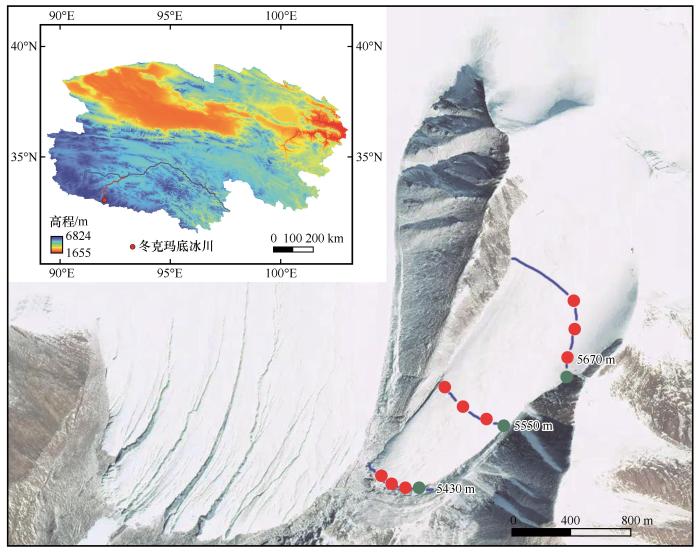
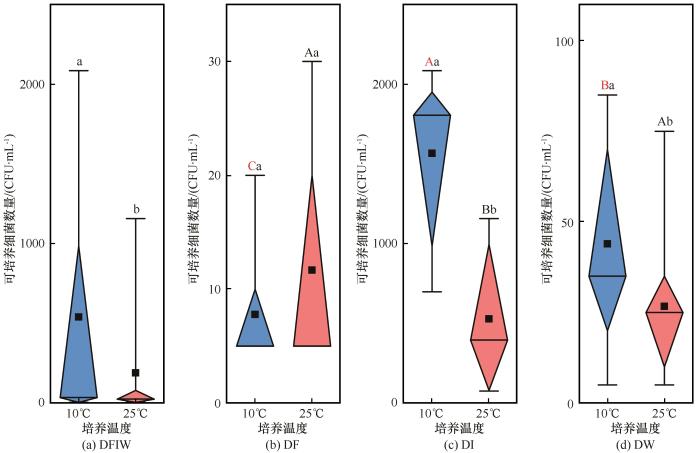
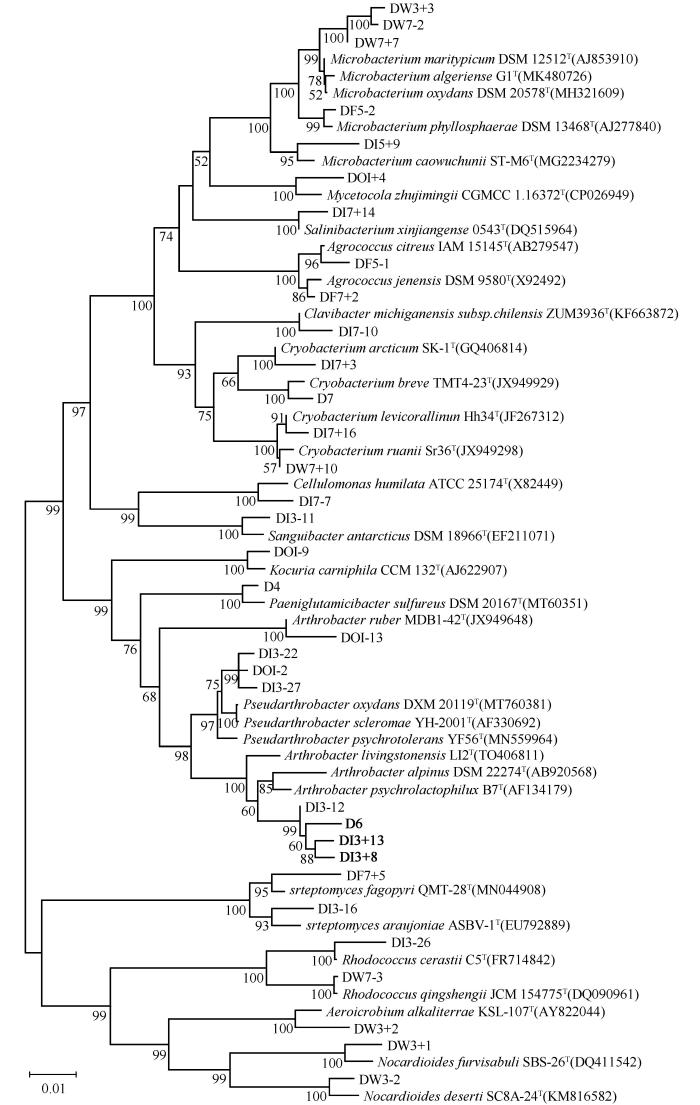
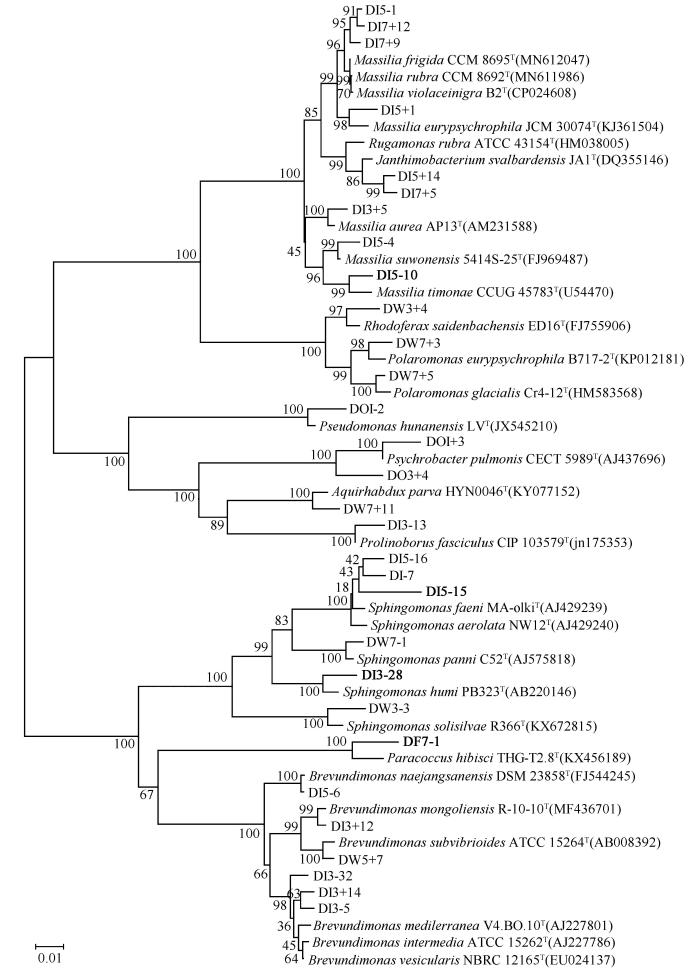
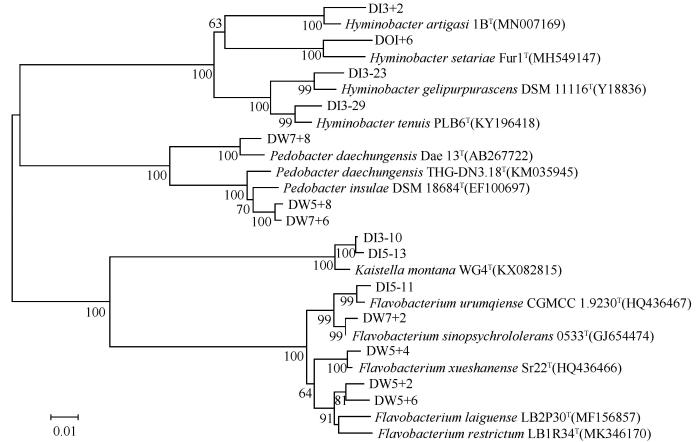
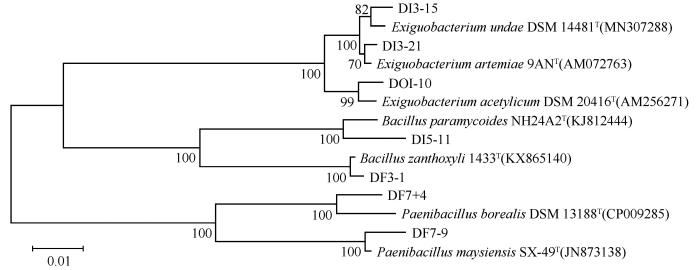
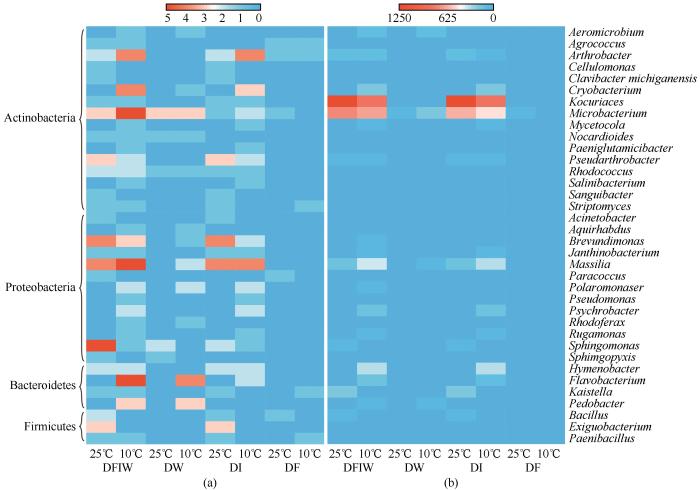
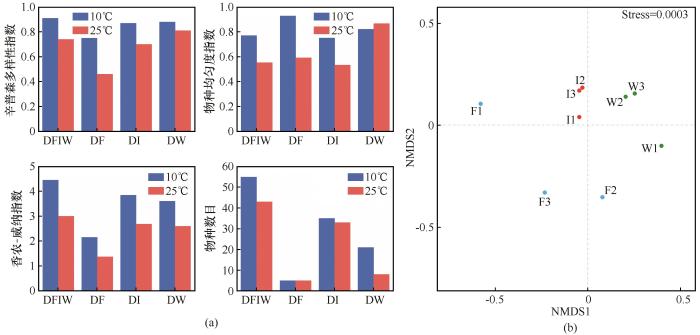

 甘公网安备 62010202000676号
甘公网安备 62010202000676号